Raul Fattore
April 7, 2023
The present study is divided into six parts
Part-1 Part-3 Part-4 Part-5 Part-6
Table of Contents
In This Paper
In this study, two nuclear wave equations are derived for the nucleus of the Aluminum atom:
- A nuclear wave equation from the shells’ self-oscillations
- A nuclear interference wave equation by applying an external wave
Having better knowledge about atomic nucleus dynamics may give us additional information which could be useful for experimental purposes.
Abstract
Some efforts have been made to prove negative mass behavior through some experiments performed in mechanics [1], and other disciplines [9], as well as some theories in electrostatics [2,3,4,5,6,7,8], but I haven’t found research about similar effects at the atomic level, where the most elementary mass given by the atomic nucleus is to be found.
- Is the second Newton’s law still valid with negative mass?
- What could happen if we make the atom behave in a negative mass regime?
- Is the negative refractive index related to negative mass?
- Are we able to control the magnitude of mass?
- Are we able to control the sign of mass?
The answers to these questions are given through this series of papers, with results that are coincident with experimental data, except for the negative mass regime. Experiments must be done to confirm or invalidate the theory developed in these articles. Needless to say, if experiments validate this theory, then a significant change in mankind is going to happen. In that case, I strongly ask scientists to cooperate by making use of the derived technologies for good and refrain from doing it for evil.
Introduction
The theory presented in these papers, as described in Part-1, is based on three fundamental aspects that have proved to be extremely effective to describe physical phenomena and predicting results that agree with experimental data [10, 11, 12]:
• Spinning Ring Model of Elementary Particles (toroidal ring of continuous charge)
• New Atomic Model
• The Universal Electrodynamic Force
Based on the new atomic model, a shell arrangement of the nuclear particles has been assumed in Part 1, as shown in Fig. 1.

Assumed shell arrangemet for Aluminum atomic nucleus
This sandwich configuration keeps the particles very tightly bound together. Note that at three shells in from the outermost shell, there are always two proton shells in a row for the larger nuclides.
This weak binding allows the outermost sandwich of shells to have liquid-like properties and forms the proper justification for a Liquid Drop Model of the nucleus.
As we already know, the torus ring model of the particles has an associated electric field as well as a magnetic field. However, due to the very tight packing configuration of the particles, we may safely assume that the distance among shells is extremely tiny and that the predominant force in the nucleus is of electrostatic origin, while the weaker magnetic forces will add some contribution to the equilibrium distance between each shell. As demonstrated in Part 1, mass is an intrinsic property of the atomic nucleus. Under natural circumstances, it has a constant universal magnitude and is always positive. However, with some proper external agents, we might be able to manipulate the intrinsic mass by changing its magnitude and sign.
Derivation of the Nuclear Wave Equation for Shells’ Self-Oscillations
A nuclear wave equation is derived specifically for Aluminum (Al 13) in accordance with the nuclear shell packing proposed by the atomic theory of the Spinning Ring Model of Elementary Particles, with a Liquid Drop Model of the nucleus (Fig. 1).
A more general nuclear wave equation valid for any atomic nucleus might be derived by following a similar procedure. I leave this task to other scientists.
We have assumed that the predominant force in the nucleus is of electrostatic origin, while the weaker magnetic forces will add some contribution to the equilibrium distance between each shell. Even though magnetic forces are not specifically considered for the derivation of the wave equation, the universal force used in the derivation already accounts not only for static but also for dynamic electric and magnetic fields.
We have previously seen in Part-1 that the net force is the sum of 2 terms (Eq. 23):
- From opposite charges’ interactions
- From equal charges’ interactions
 (1)
(1)
Let’s define the charge factor for opposite charges and equal charges from the interaction of Coulomb forces:
![]() (charge factor for opposite sign charges, from Coulomb force interaction)
(charge factor for opposite sign charges, from Coulomb force interaction)
![]() (charge factor for equal sign charges, from Coulomb force interaction)
(charge factor for equal sign charges, from Coulomb force interaction)
Let’s define the average constant distance among shells as: ![]()
Then, we can write the force as
 (2)
(2)
By having a closer look at the force, we see that the two terms are no other than a dynamic electric field, and a static electric field. Therefore, the net force can be written as
![]() (3)
(3)
Where:
 (4)
(4)
![]() (5)
(5)
Recall that the unit vector ![]() is a function of time, i.e.,
is a function of time, i.e., ![]() . We have to take this into account when we take derivatives with respect to time. To simplify the notation, in most cases we simply write it as
. We have to take this into account when we take derivatives with respect to time. To simplify the notation, in most cases we simply write it as ![]() .
.
The total derivative of the net force given in Eq. 3 is:
 (6)
(6)
Taking the partial derivative of Eq. 6 with respect to ![]()
 (7)
(7)
Considering that:
![]() ;
; ![]() ;
; ![]()
Then, Eq. 7 becomes
![]() (8)
(8)
Taking the partial derivative of Eq. 6 with respect to ![]()
 (9)
(9)
Considering that:
![]() ;
; ![]()
![]()
Shell oscillations occur in the radial direction, coincident with the nucleus radius line. Therefore, the electric field has no component in ![]() nor in
nor in ![]() directions. That means:
directions. That means:
![]() and
and ![]()
Then, Eq. 9 becomes
![]() (10)
(10)
Now we take the derivative of Eq. (8) with respect to time, which gives 
Since the components in the direction of ![]() and
and ![]() are zero, the equation is reduced to
are zero, the equation is reduced to
 (11)
(11)
Now we take the derivative of Eq. (10) with respect to ![]() , yielding to
, yielding to
![]() (12)
(12)
By equating Eq. (11) and Eq. (12), we obtain

After simplifying, we arrive at our final
Nuclear wave equation from Shells’ Self-Oscillations
![]() (13)
(13)
This partial differential equation (PDE) is of type hyperbolic, with variable coefficients, whose analytical solution involves a certain amount of work. To simplify this work, it will be solved numerically with initial-boundary conditions derived from the nuclear shell’s arrangements.
We can write the nuclear wave equation in a more general form as follows:
![]() (14)
(14)
The initial-boundary conditions
Let’s remember the equations of relative displacement, velocity, and acceleration between electron-proton shell pairs derived in Part 1, equations (10), (11), and (12):
![]()
![]()
![]()
![]()
Initial conditions
For ![]() we have:
we have:
![]()
![]()
![]()
Equation (4) is reduced to
![]() (15)
(15)
You can also verify that the derivative of Eq. (4) with respect to time is zero
![]() (16)
(16)
Boundary conditions
For ![]() , we have velocity and acceleration equal to zero. Then Eq. (4) is reduced to
, we have velocity and acceleration equal to zero. Then Eq. (4) is reduced to![]() (17)
(17)
Similarly, for ![]() , we have velocity and acceleration equal to zero. Then Eq. (4) becomes
, we have velocity and acceleration equal to zero. Then Eq. (4) becomes
![]() (18)
(18)
Equations (15) to (18) constitute the chosen initial and boundary conditions to obtain the solution of the nuclear wave equation for diverse parameter values.
Nuclear Radiation Frequencies from Shells’ Self-Oscillations
The nuclear wave equation (13) has been numerically solved with the initial-boundary conditions (15) to (18). Some graphs of amplitude with respect to time and displacement (snapshots) are shown below for the following parameters:
![]() ;
; ![]() ;
; ![]() ;
; ![]() ;
; ![]()
The graphs of amplitude vs. time correspond to a displacement ![]() , while the plots of amplitude vs. displacement correspond to the nucleus radius for an arbitrary time, taken within the allowed time span from the solution.
, while the plots of amplitude vs. displacement correspond to the nucleus radius for an arbitrary time, taken within the allowed time span from the solution.
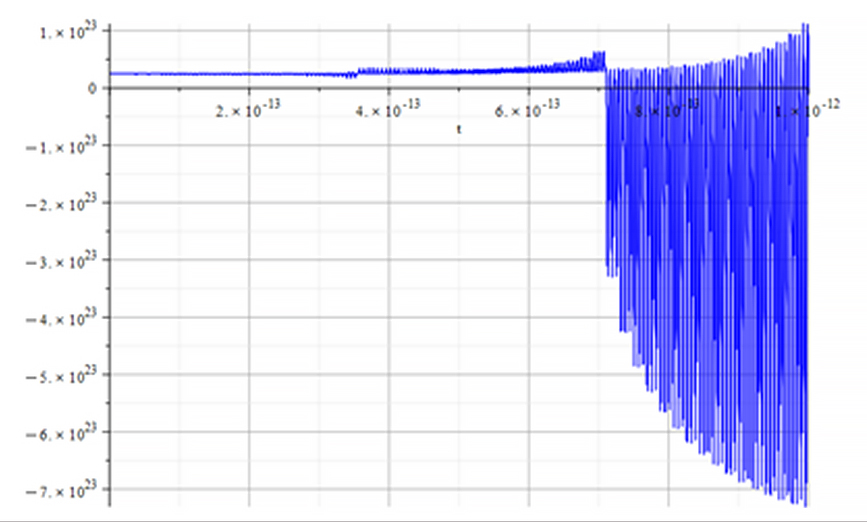 |  |
| Figure 2 Amplitude vs. time | Figure 3 Amplitude vs. displacement |
Fig. 2-3: for these additional parameters: ![]() and
and ![]() , the nuclear radiation frequency is
, the nuclear radiation frequency is ![]() .
.
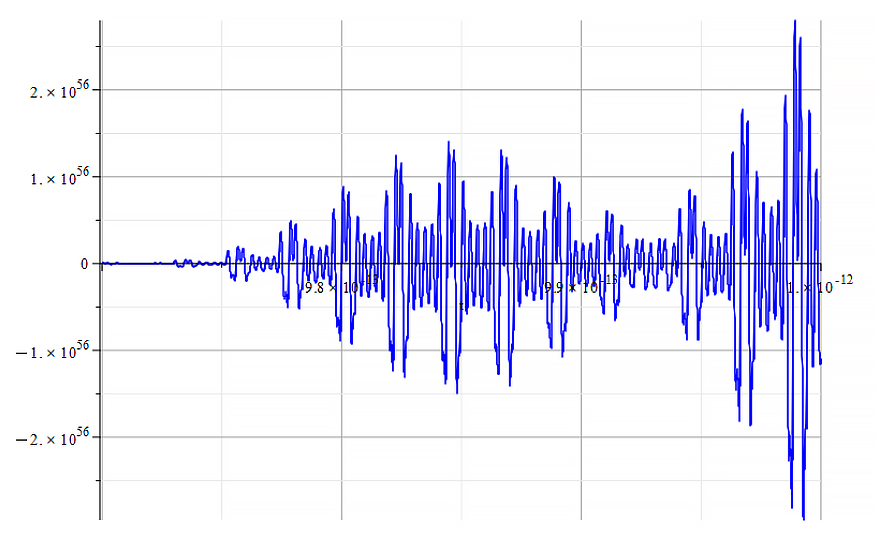 |  |
| Figure 4 Amplitude vs. time | Figure 5 Amplitude vs. displacement |
Fig. 4-5: for these additional parameters: ![]() and
and ![]() , the nuclear radiation frequency is
, the nuclear radiation frequency is ![]() .
.
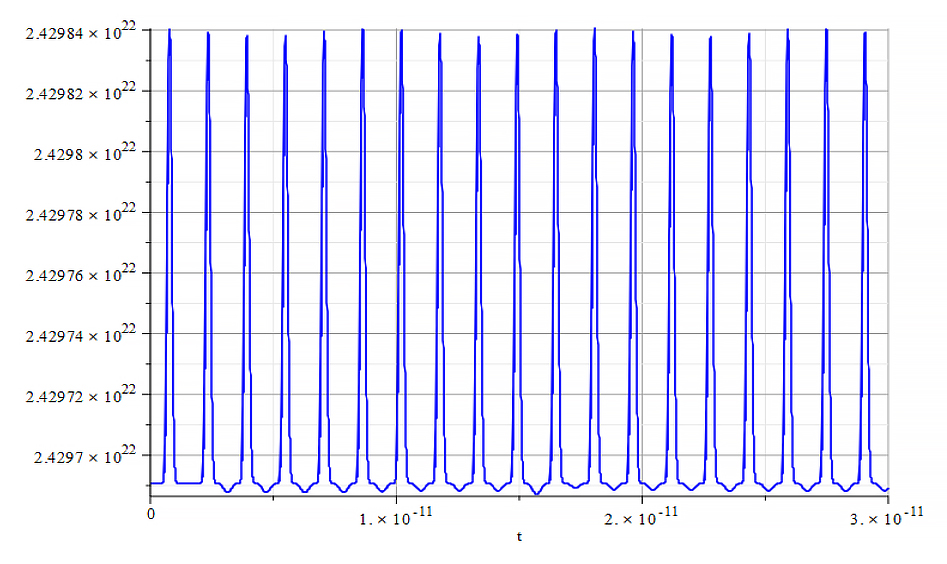 |  |
| Figure 6 Amplitude vs. time | Figure 7 Amplitude vs. displacement |
Fig. 6-7: for these additional parameters: ![]() and
and ![]() , the nuclear radiation frequency is
, the nuclear radiation frequency is ![]() .
.
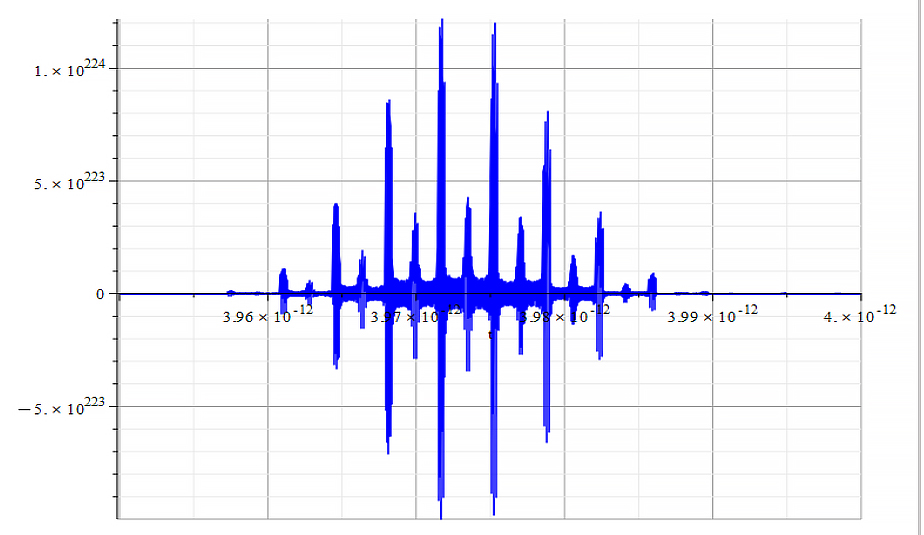 |  |
| Figure 8 Amplitude vs. time | Figure 9 Amplitude vs. displacement |
Fig. 8-9: for these additional parameters: ![]() and
and ![]() , the nuclear radiation frequency is
, the nuclear radiation frequency is ![]() , with a beat frequency of
, with a beat frequency of ![]() .
.
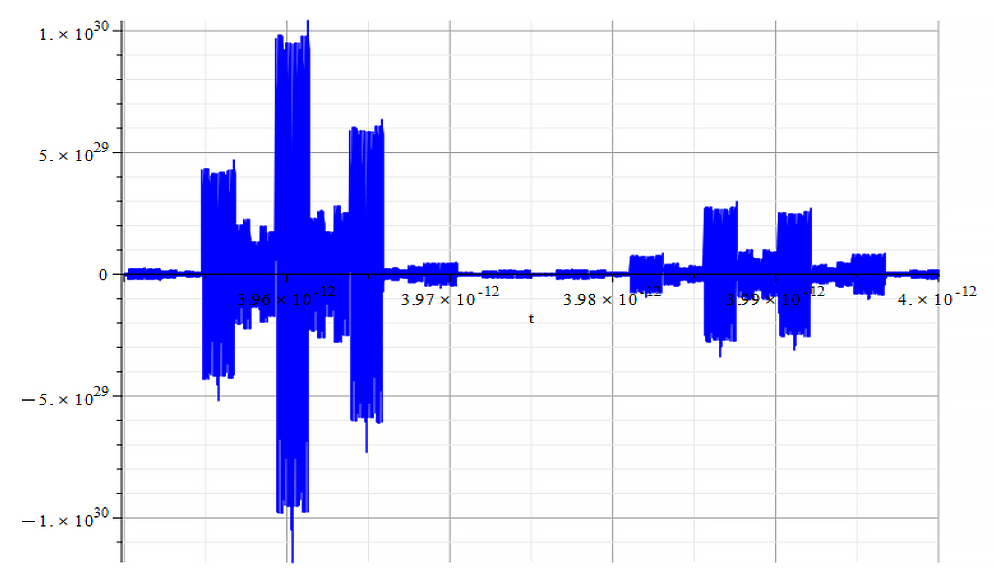 | 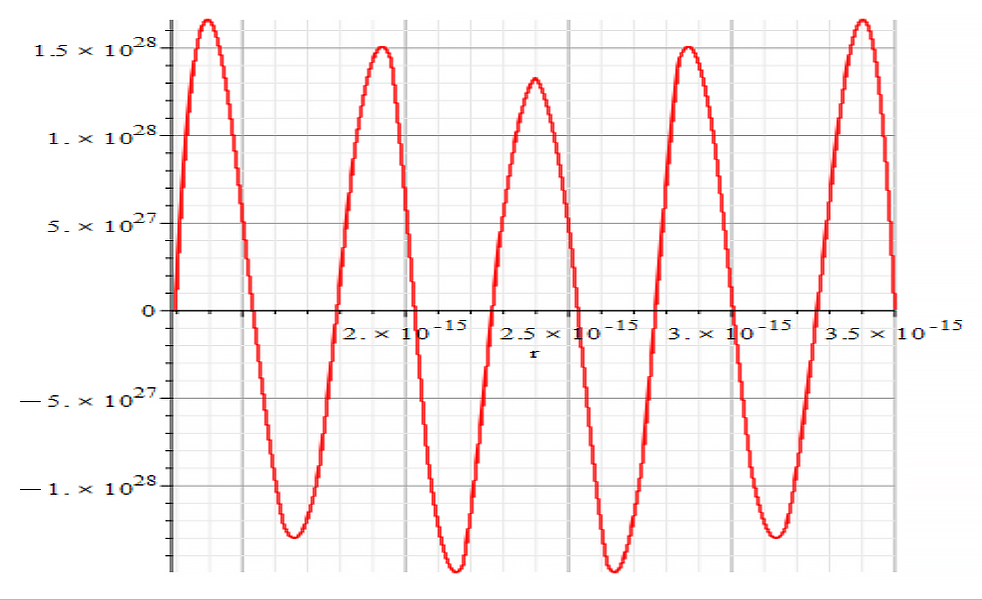 |
| Figure 10 Amplitude vs. time | Figure 11 Amplitude vs. displacement |
Fig. 10-11: for these additional parameters: ![]() and
and ![]() , the nuclear radiation frequency is
, the nuclear radiation frequency is ![]() .
.
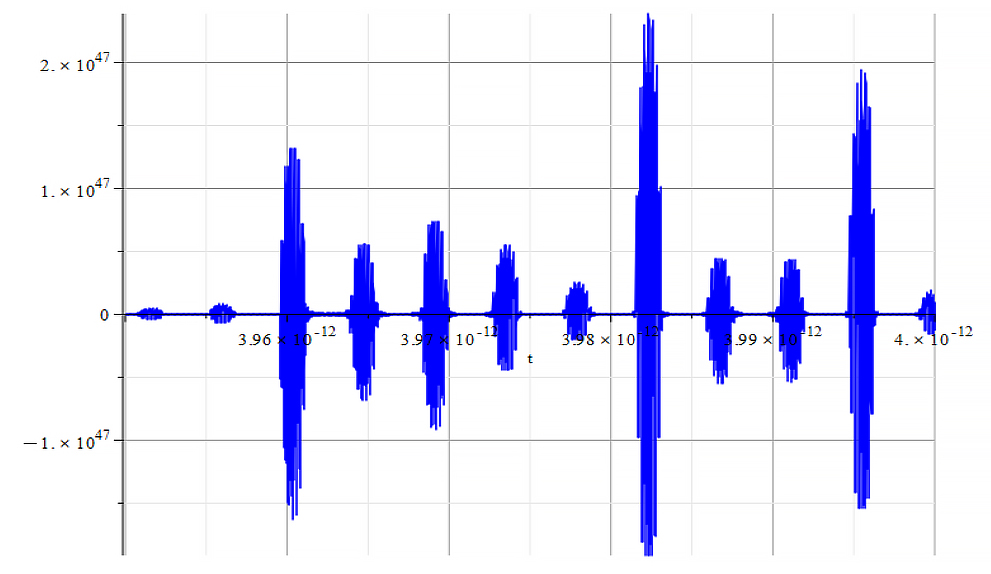 | 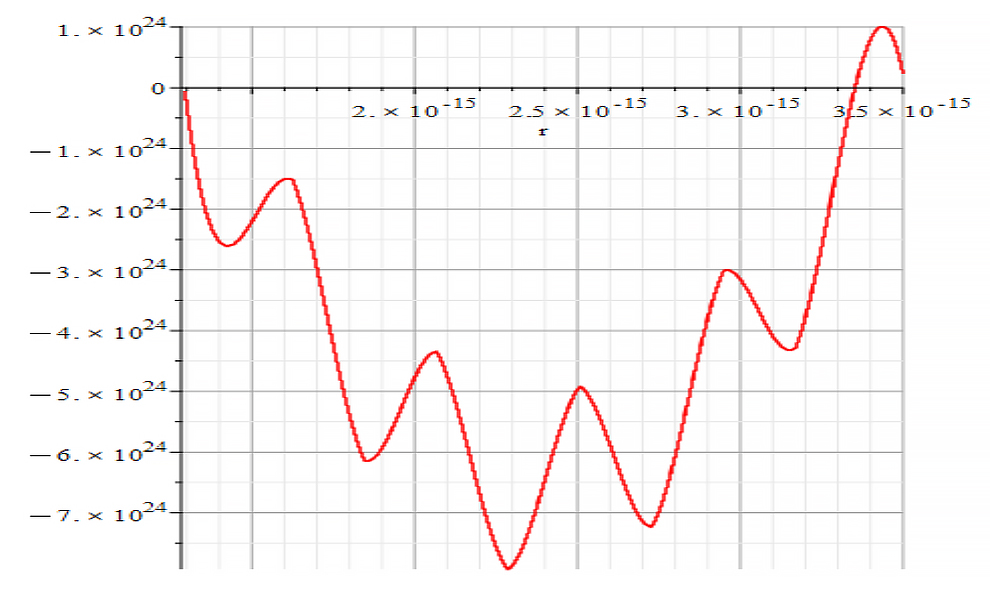 |
| Figure 12 Amplitude vs. time | Figure 13 Amplitude vs. displacement |
Fig. 12-13: for these additional parameters: ![]() and
and ![]() , the nuclear radiation frequency is
, the nuclear radiation frequency is ![]() .
.
According to the National Institute of Standards and Technology, the emission spectrum of Aluminum is in the range of frequencies ![]() to
to ![]() .
.
The nuclear radiation frequencies in Fig. 2 and Fig. 4 are approximately within the range of emission of the Aluminum. This tells us that the frequency of oscillation of electron and proton shells should be approximately in the range of ![]() to
to ![]() .
.
Derivation of a Nuclear Interference Wave Equation by Applying an External Wave
Remember that the nuclear wave equation is derived specifically for Aluminum (Al 13) in accordance with the nuclear shell packing proposed by the atomic theory of the Spinning Ring Model of Elementary Particles, with a Liquid Drop Model of the nucleus (Fig. 1).
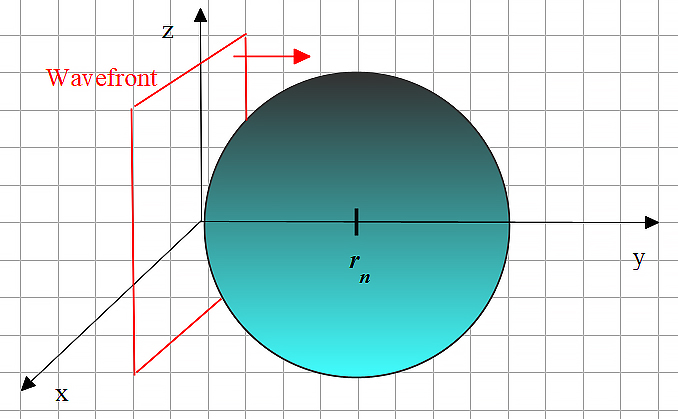
External wavefront reaching the nucleus
Assume that a plane wave of amplitude ![]() , frequency
, frequency ![]() , and propagation velocity
, and propagation velocity ![]() in the y-direction strikes the outer shell of the “nuclear sphere”.
in the y-direction strikes the outer shell of the “nuclear sphere”.
We disregard some minor scattering caused by the few outer electrons in the atom, which are located at a very long distance from the nucleus. The incident wave energy may be totally absorbed, partially absorbed, or not absorbed at all by the nuclear shells.
Inside the nucleus, the wave velocity will be given by the velocity of oscillations of the proton and electron shells if they can absorb the incident energy. If the shells are unable to absorb energy (total transmission), the wave velocity inside the nucleus will remain unaltered (by keeping the velocity it had before entering the nucleus).
The highest energy absorption (no reflection, no transmission) will happen at the shells’ resonant frequencies, at which the nuclear mass becomes negative, just as the refractive index (see Part-3). High-energy standing waves will arise inside the nucleus.
An intermediate situation may occur when the energy is partially absorbed (reflection and transmission). In this case, a modulation is present (beat frequency) between the wave and the shell’s oscillations frequencies.
Assume that the wave has the following equation (we write the wave vector in a capital letter as ![]() to avoid confusion with the Coulomb constant :
to avoid confusion with the Coulomb constant :
![]() (19)
(19)
Where ![]() is the amplitude of the external wave.
is the amplitude of the external wave.
As the wave propagates in the y-direction, the wave vector is ![]() , with magnitude
, with magnitude ![]() . In spherical coordinates we have
. In spherical coordinates we have
![]() (20)
(20)
Since the magnitude of the vector ![]() limited to the nucleus is
limited to the nucleus is ![]() , we can write
, we can write ![]() . The dot product is
. The dot product is ![]() . According to the propagation in the y-direction,
. According to the propagation in the y-direction, ![]() . So, the dot product result is
. So, the dot product result is ![]() , and the wave equation for our plane wavefront propagating in the y-direction finally is
, and the wave equation for our plane wavefront propagating in the y-direction finally is
![]() (21)
(21)
Where ![]() is the magnitude of the electric field.
is the magnitude of the electric field.
We have a propagating electric field, but what is the direction of the field?
Assume that the electric field is polarized in the z-direction in the zy-plane. Then we can write
![]() , which converted to spherical coordinates is
, which converted to spherical coordinates is
![]()
The polar angle in the z-direction is ![]() . Therefore, our final expression of an oscillating electric field in the z-direction, which moves in the y-direction is:
. Therefore, our final expression of an oscillating electric field in the z-direction, which moves in the y-direction is:
![]() (22)
(22)
Where the magnitude is as given in (21), and ![]() . The velocity
. The velocity ![]() is generic. Then, in the solution, we can replace it with
is generic. Then, in the solution, we can replace it with ![]() or
or ![]() (speed of light) to study nuclear behaviors in absorption or transmission situations.
(speed of light) to study nuclear behaviors in absorption or transmission situations.
Let’s make a rough approximation of the total force exerted by the wave on the nucleus as the sum of the forces on every proton and electron which form the nuclear shells. According to our 6 shells structure (Fig. 1), we have:
![]() =>
=> ![]() =>
=> ![]()
![]() (23)
(23)
The net nuclear force has already been derived in Part-1, and written in compact form, as given in equations (3). The total force on the nucleus will be
![]()
![]() (24)
(24)
Assume that the total force is a function of the following variables
![]()
Then, the total derivative is given by
 (25)
(25)
The partial derivative of (25) with respect to ![]() is
is
 (26)
(26)
Considering that
![]() ;
; ![]() (we assume the amplitude of the wave keeps constant throughout the nucleus diameter)
(we assume the amplitude of the wave keeps constant throughout the nucleus diameter)
![]() (we assume that frequency doesn’t change with distance)
(we assume that frequency doesn’t change with distance)
![]() ;
; ![]() ;
; ![]()
Then, Eq. (26) is reduced to
 (27)
(27)
Now we take the partial derivative of (25) with respect to ![]()
 (28)
(28)
Considering that
![]() ;
; ![]() (we assume the amplitude of the wave keeps constant in time)
(we assume the amplitude of the wave keeps constant in time)
![]() (we assume that frequency doesn’t change with time)
(we assume that frequency doesn’t change with time)
![]() ;
; ![]()
![]()
Recall that ![]() . Its derivative with respect to time is
. Its derivative with respect to time is
![]()
Shell oscillations occur in the radial direction, coincident with the nucleus radius line. Therefore, the internal electric field ![]() has no component in
has no component in ![]() nor in
nor in ![]() directions. Therefore,
directions. Therefore,
![]() and
and ![]()
Equation (28) is then reduced to
 (29)
(29)
By taking the derivative of Eq. (27) with respect to ![]() , and considering that the components in
, and considering that the components in ![]() and
and ![]() directions are zero, we obtain:
directions are zero, we obtain:

 (30)
(30)
By taking the derivative of Eq. (29) with respect to ![]() , we get
, we get
![]() (31)
(31)
We see that Eq. (30) = Eq. (31). After equating both equations, simplifying terms, and doing some algebra, we arrive at our final Nuclear Interference Wave Equation:
 (32)
(32)
Written in a more general form:
 (32a)
(32a)
This partial differential equation (PDE) is of type hyperbolic, with variable coefficients, whose analytical solution involves a certain amount of work. To simplify this work, it will be solved numerically with the same initial-boundary conditions as given from Eq. (15) to (18) for the wave equation (14).
Nuclear Wave Interference Analysis
The nuclear wave equation (14) has been numerically solved with the initial-boundary conditions (15) to (18). Some graphs of amplitude with respect to time and displacement (snapshots) are shown below for the following parameters:
![]() ;
; ![]() ;
; ![]() ;
; ![]() ;
; ![]()
The analysis will be separated into two parts, by considering the absorption and transmission of energy by the nucleus:
- Absorption: velocity of the external wave in the nucleus equal to the velocity of the shell’s oscillations, i.e.,

- Transmission: velocity of the external wave in the nucleus equal to the speed of light
 .
.
Nuclear Wave Interference Under Nuclear Absorption of Energy
In this case, the following external wave variables have been set: ![]() and
and ![]() . As the Aluminum electric breakdown is approximately
. As the Aluminum electric breakdown is approximately ![]() , the amplitude of the external wave was kept below that value at
, the amplitude of the external wave was kept below that value at ![]() , while the frequency was changed to reflect the shifts between positive and negative amplitudes of the wave interference.
, while the frequency was changed to reflect the shifts between positive and negative amplitudes of the wave interference.
The graphs of amplitude vs. time correspond to a displacement ![]() , while the plots of amplitude vs. displacement correspond to the nucleus radius for an arbitrary time, taken within the allowed time span from the solution.
, while the plots of amplitude vs. displacement correspond to the nucleus radius for an arbitrary time, taken within the allowed time span from the solution.
When the previous wave equation (13) was solved, it was shown that there are natural interferences causing resonance and standing waves in the nucleus, which are demonstrated by the “beats” and “double beats” on those graphs. Then, in the present analysis, we can expect “beats of double beats” caused by the external wave.
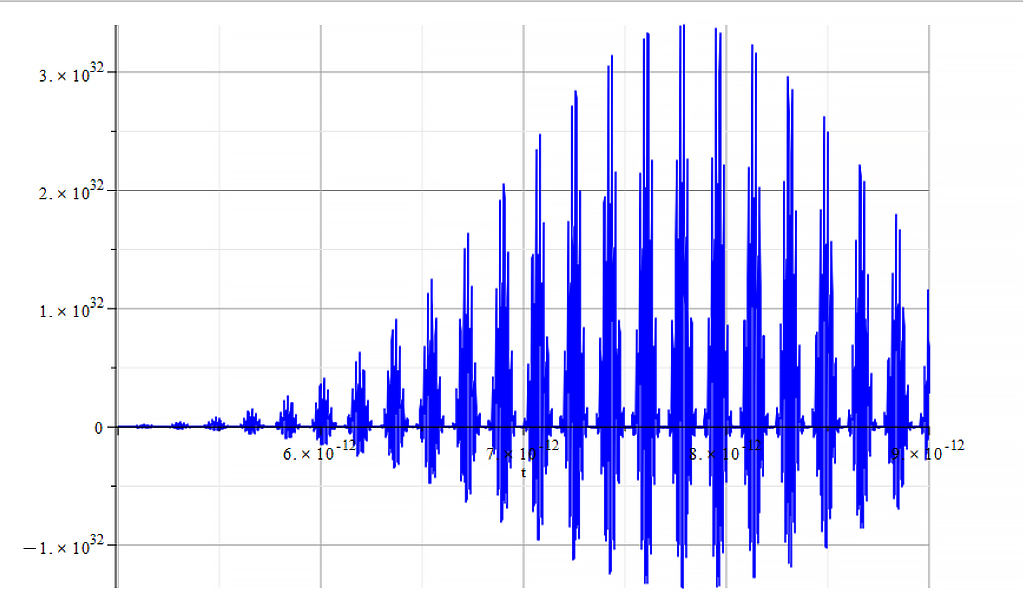 | 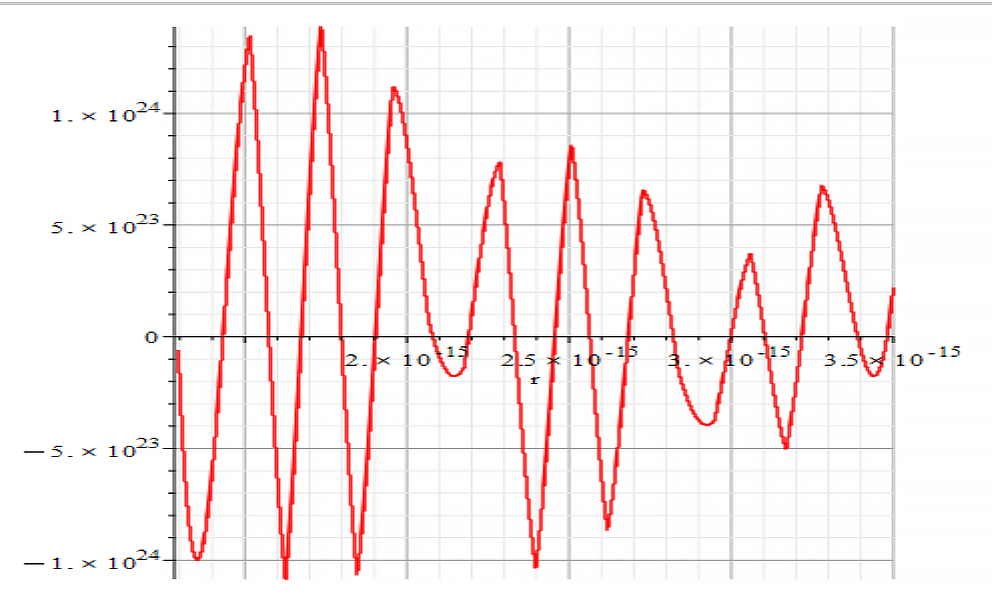 |
| Figure 15 Amplitude vs. time | Figure 16 Amplitude vs. displacement |
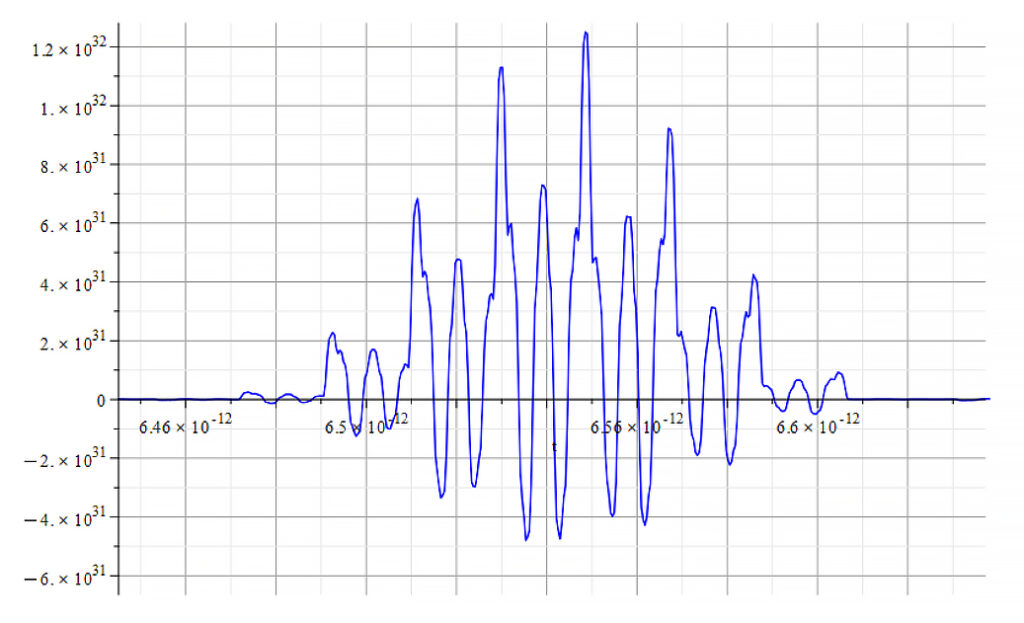
Amplitude vs, time. Expanding one packet (beat)
Fig. 15-17: No external wave is acting on the nucleus (natural nuclear emission), i.e., ![]() .
.
Additional parameters: ![]() and
and ![]() .
.
Low frequency beat: ![]() ; high frequency beat:
; high frequency beat: ![]() ; “carrier” frequency:
; “carrier” frequency: ![]()
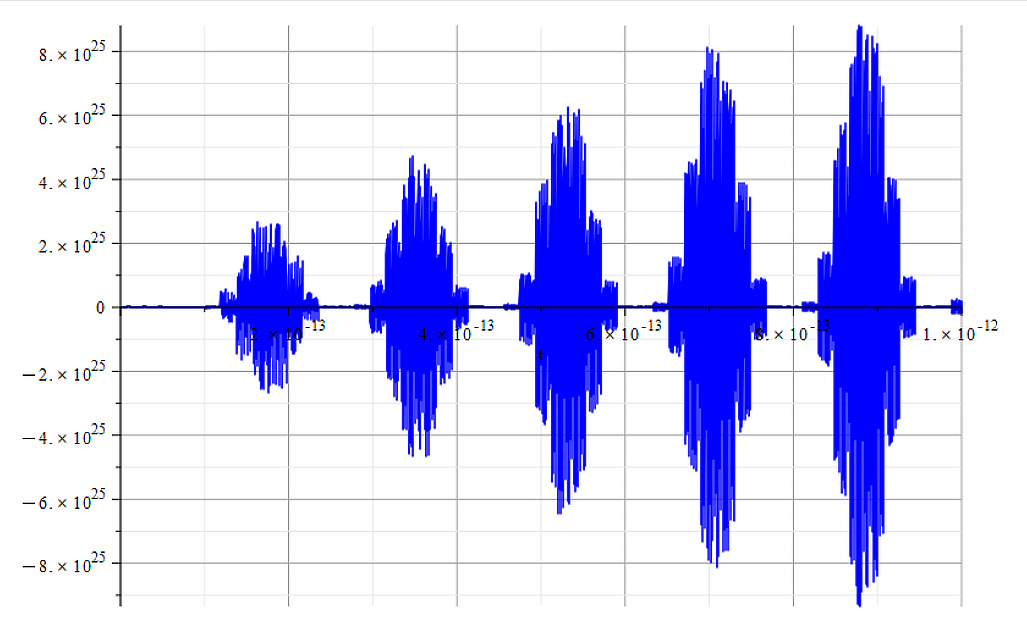 |  |
| Figure 18 Amplitude vs. time | Figure 19 Amplitude vs. displacement |
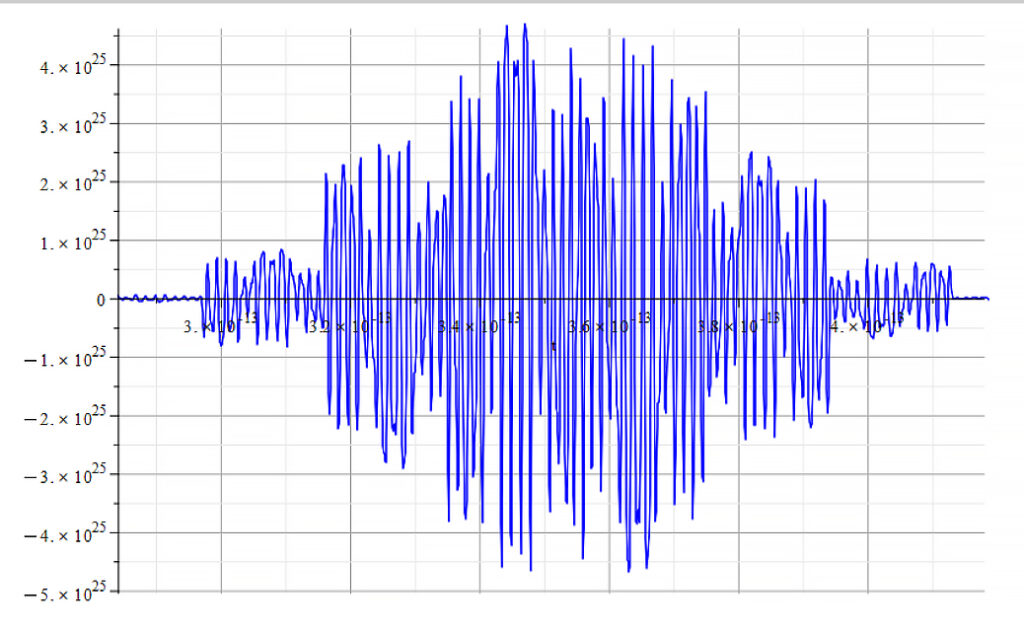
Amplitude vs, time. Expanding one big packet (double beat)
Fig. 18-20: external wave is acting on the nucleus ![]() ;
; ![]()
Additional parameters: ![]() and
and ![]() .
.
Low frequency beat: ![]() ; high frequency beat:
; high frequency beat: ![]() ; “carrier” frequency:
; “carrier” frequency: ![]()
No changes were observed with respect to the previous case.
 | 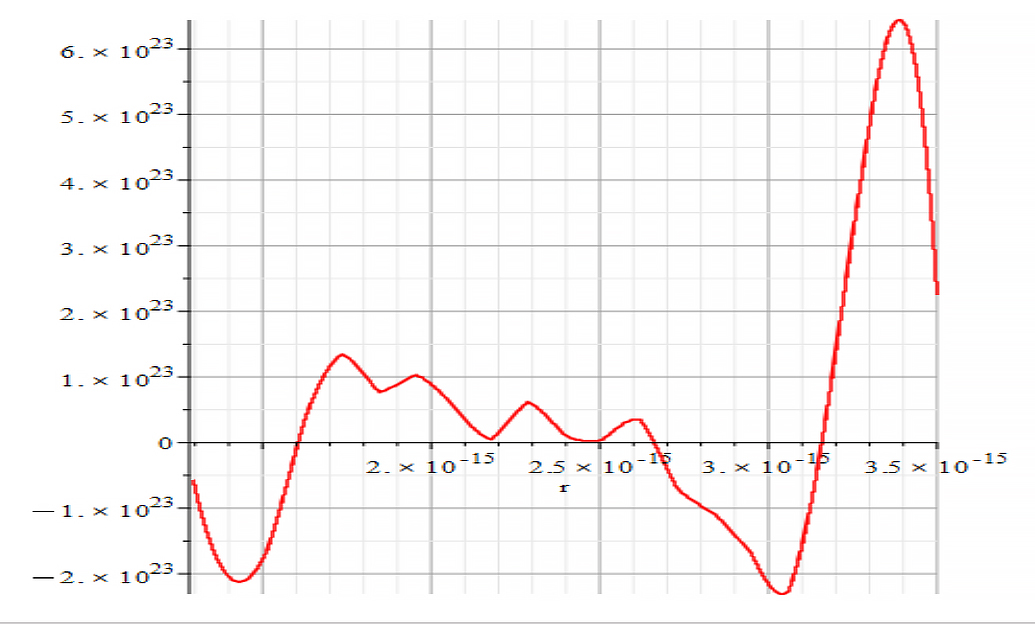 |
| Figure 21 Amplitude vs. time | Figure 22 Amplitude vs. displacement |

Amplitude vs, time. Expanding one big packet (double beat)
Fig. 21-23: external wave is acting on the nucleus ![]() ;
; ![]()
Additional parameters: ![]() and
and ![]() .
.
Low frequency beat: ![]() ; high frequency beat:
; high frequency beat: ![]() ; “carrier” frequency:
; “carrier” frequency: ![]() .
.
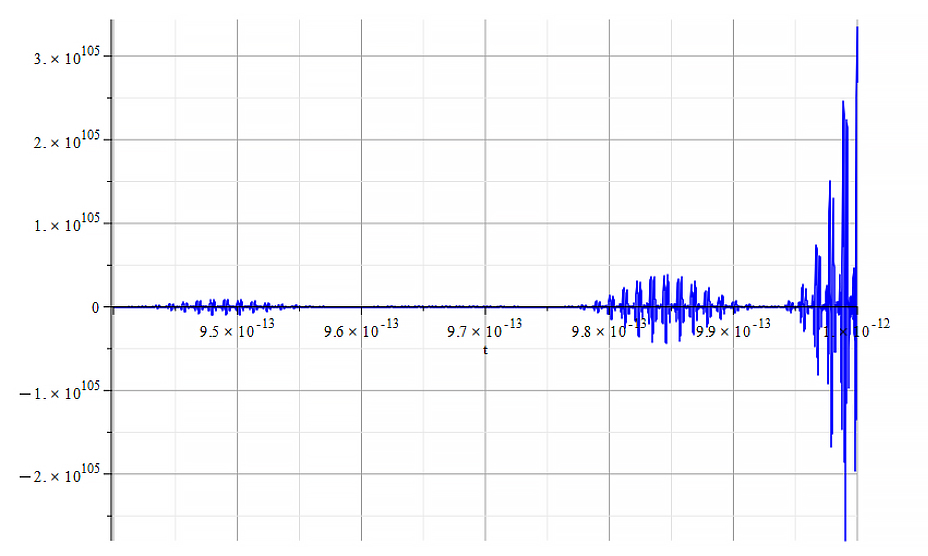 | 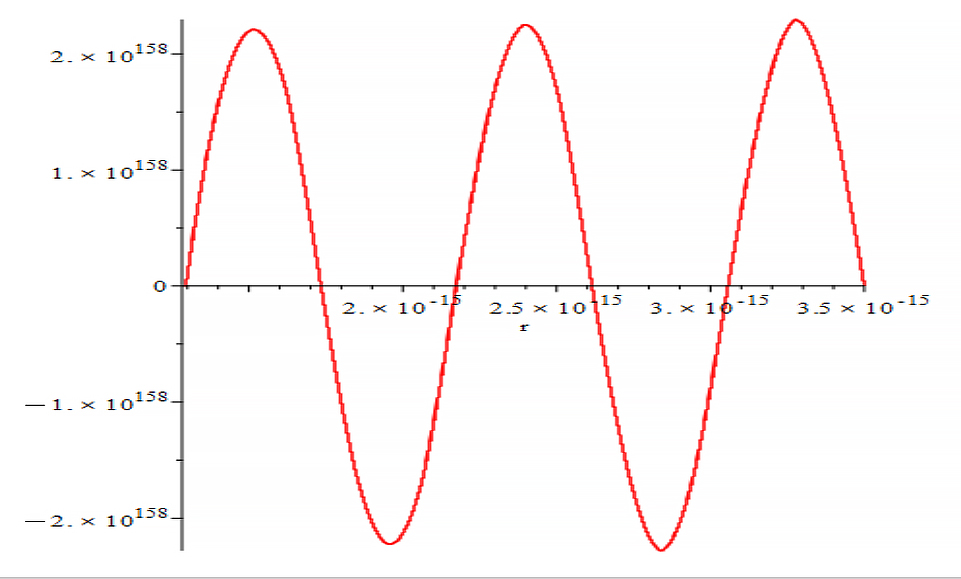 |
| Figure 24 Amplitude vs. time | Figure 25 Amplitude vs. displacement |

Amplitude vs, time. Expanding one big packet (double beat)
Fig. 24-26: external wave is acting on the nucleus ![]() ;
; ![]()
Additional parameters: ![]() and
and ![]() .
.
Low frequency beat: ![]() ; high frequency beat:
; high frequency beat: ![]() ; “carrier” frequency:
; “carrier” frequency: ![]() .
.
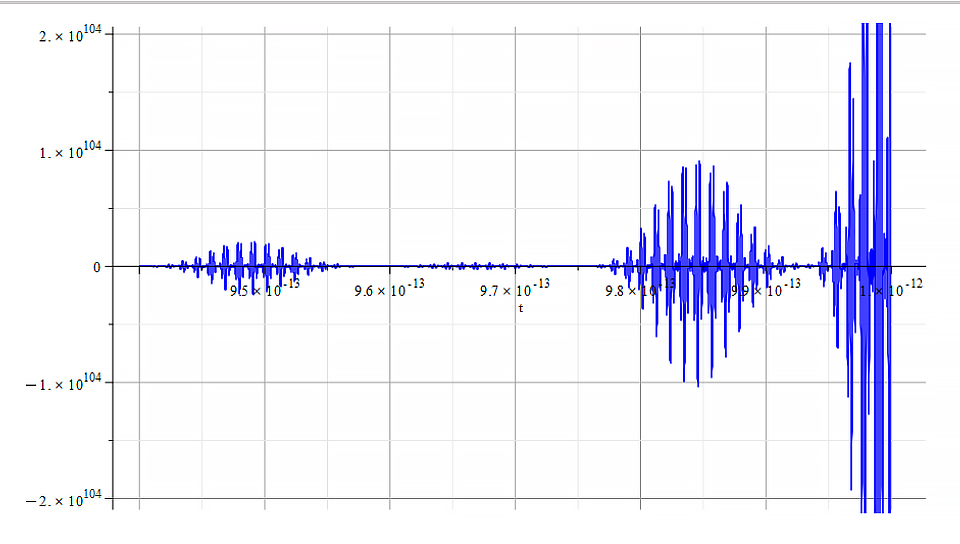 | 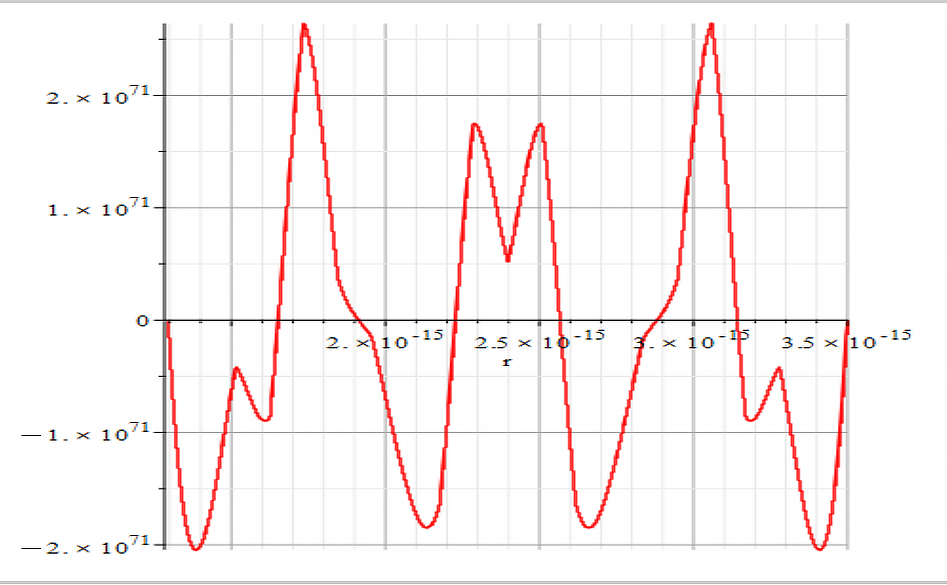 |
| Figure 27 Amplitude vs. time | Figure 28 Amplitude vs. displacement |

Amplitude vs, time. Expanding one big packet (double beat)
Fig. 27-29: external wave is acting on the nucleus ![]() ;
; ![]()
Additional parameters: ![]() and
and ![]() . Low frequency beat:
. Low frequency beat: ![]() ; high frequency beat:
; high frequency beat: ![]() ; “carrier” frequency:
; “carrier” frequency: ![]() .
.
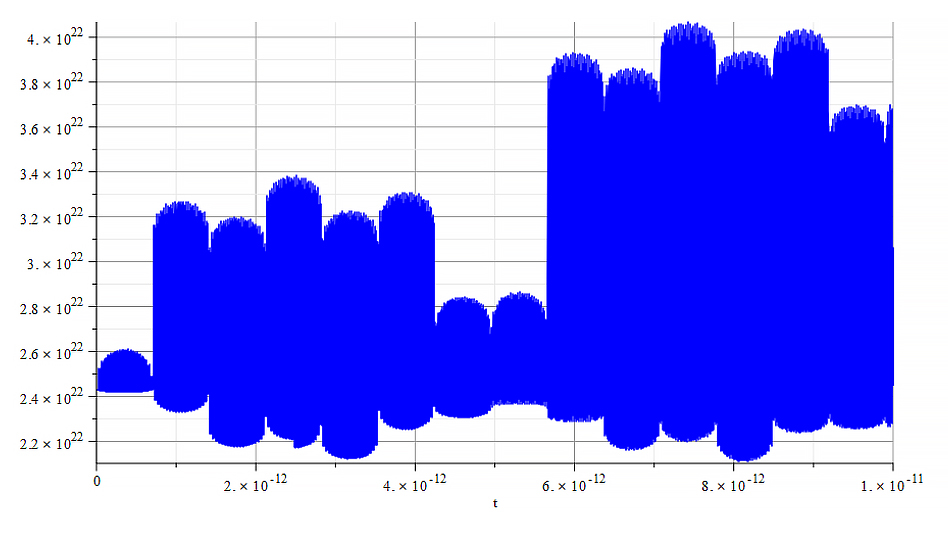 | 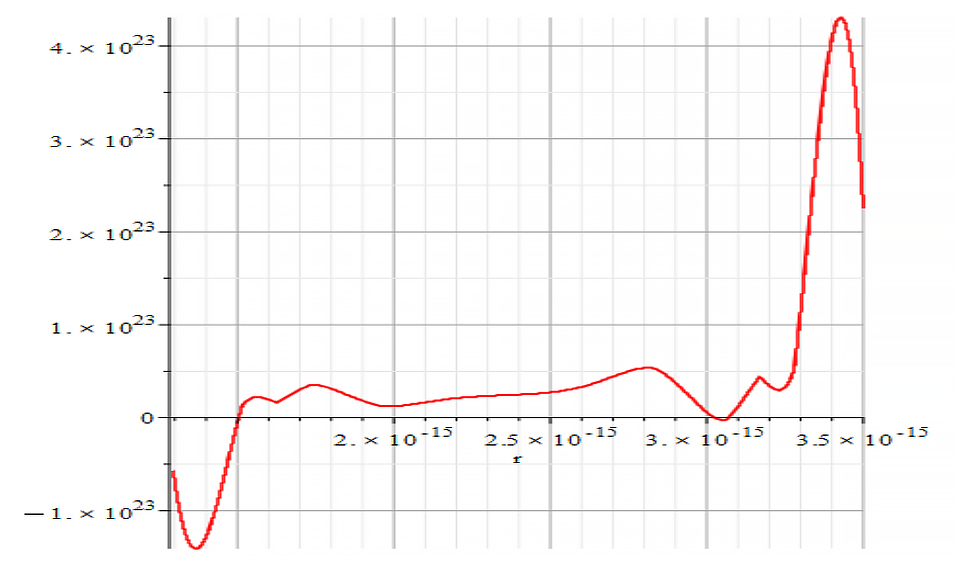 |
| Figure 30 Amplitude vs. time | Figure 31 Amplitude vs. displacement |

Amplitude vs. time. Partial expansion of beats
Fig. 30-32: external wave is acting on the nucleus ![]() ;
; ![]()
Additional parameters: ![]() and
and ![]() .
.
Beat frequency: ![]() ; “carrier” frequency:
; “carrier” frequency: ![]() .
.
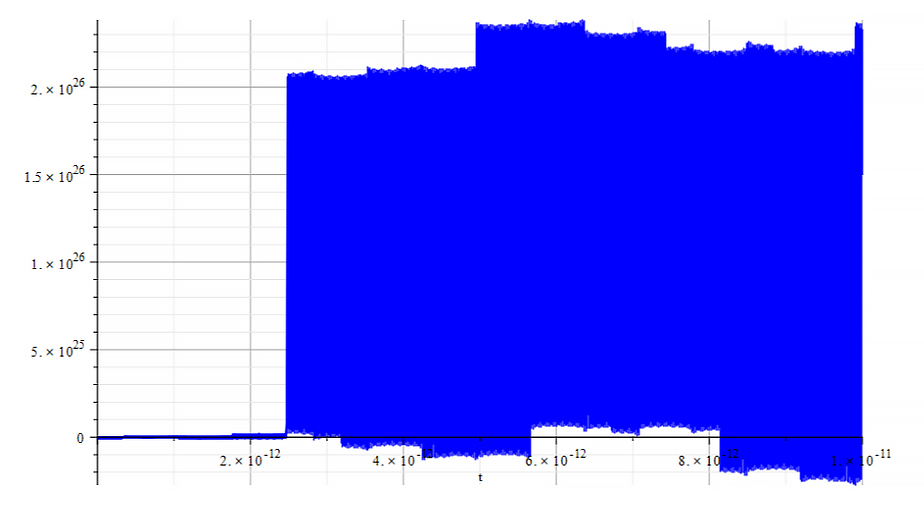 | 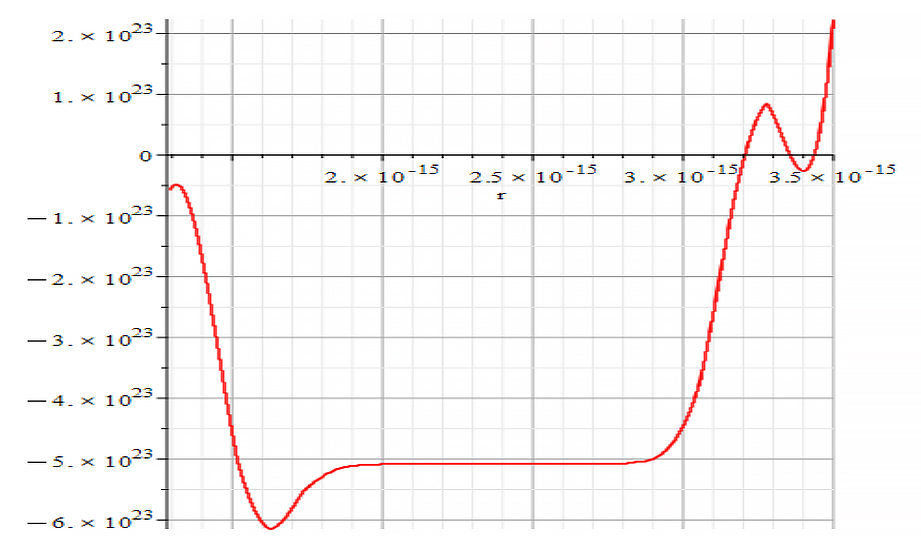 |
| Figure 33 Amplitude vs. time | Figure 34 Amplitude vs. displacement |
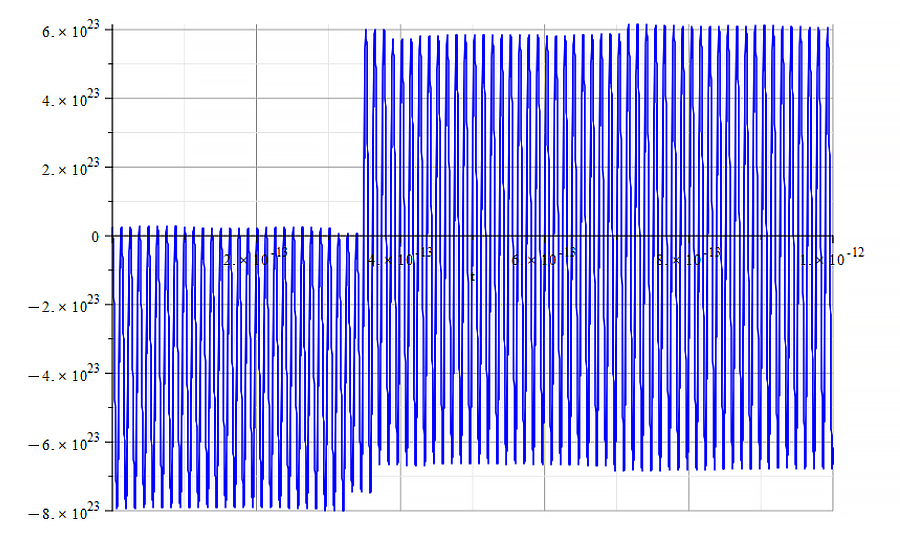
Amplitude vs. time. Partial expansion of beats
Fig. 33-35: external wave is acting on the nucleus ![]() ;
; ![]()
Additional parameters: ![]() and
and ![]() . Beat frequency:
. Beat frequency: ![]() ; “carrier” frequency:
; “carrier” frequency: ![]() .
.
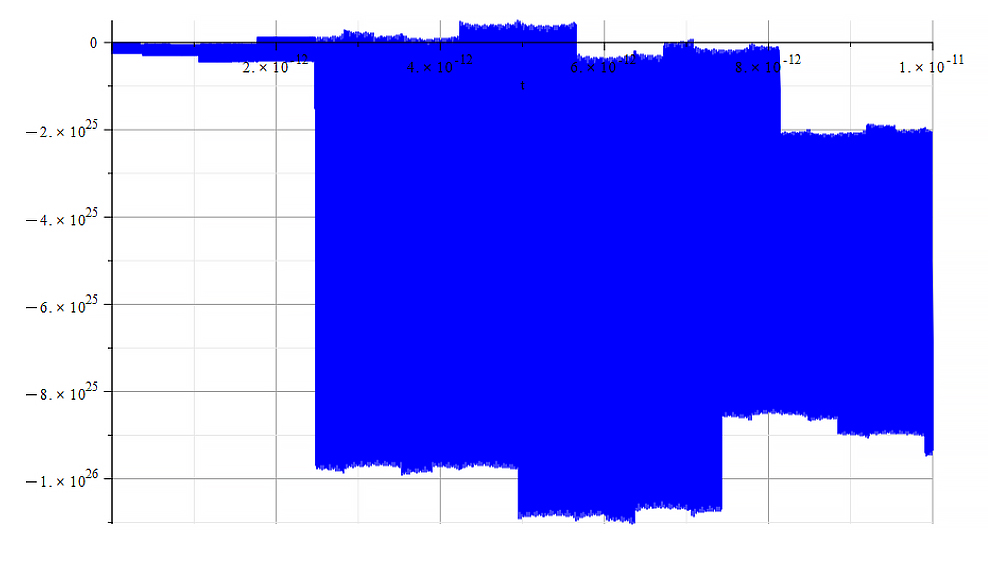 | 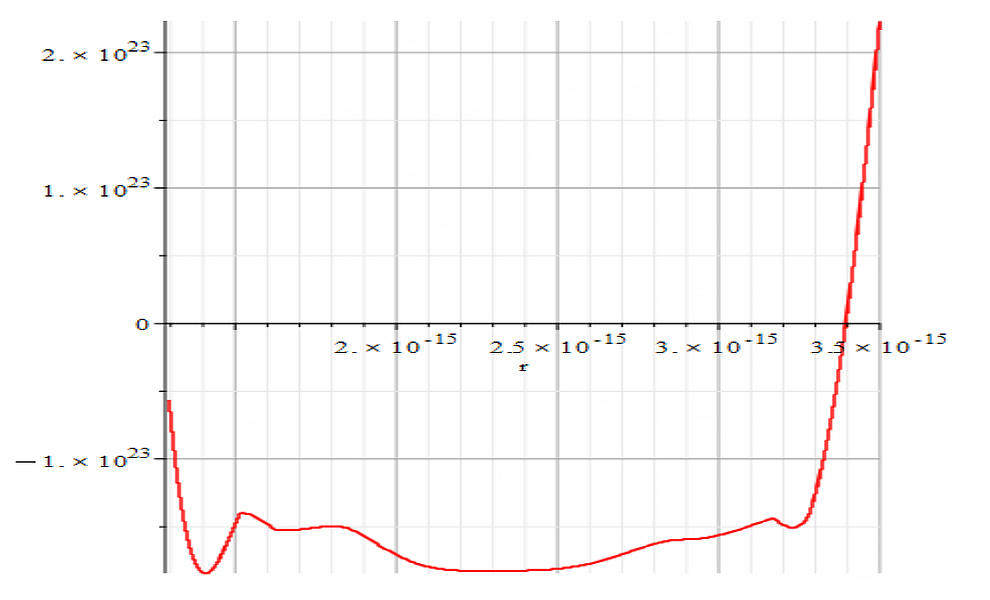 |
| Figure 36 Amplitude vs. time | Figure 37 Amplitude vs. displacement |

Amplitude vs. time. Partial expansion of beats
Fig. 36-38: external wave is acting on the nucleus ![]() ;
; ![]()
Additional parameters: ![]() and
and ![]() . Beat frequency:
. Beat frequency: ![]() ; “carrier” frequency:
; “carrier” frequency: ![]() .
.
As previously demonstrated from the emission of Aluminum, the frequency of oscillation of electron and proton shells should be approximately in the range of ![]() to
to ![]() . Approximately within this range, interference effects have been observed to begin for an external wave frequency of
. Approximately within this range, interference effects have been observed to begin for an external wave frequency of ![]() , which corresponds to the range of Near UV – Extreme UV.
, which corresponds to the range of Near UV – Extreme UV.
Nuclear Wave Interference Under Nuclear Transmission of Energy
In this case, the following external wave variables have been set: ![]() and
and ![]() . As the Aluminum electric breakdown is approximately
. As the Aluminum electric breakdown is approximately ![]() , the amplitude of the external wave was kept below that value at
, the amplitude of the external wave was kept below that value at ![]() , while the frequency was changed to reflect the shifts between positive and negative amplitudes of the wave interference.
, while the frequency was changed to reflect the shifts between positive and negative amplitudes of the wave interference.
The graphs of amplitude vs. time correspond to an arbitrary displacement, while the plots of amplitude vs. displacement correspond to the nucleus radius for an arbitrary time, taken within the allowed time span from the solution.
When the previous wave equation (13) was solved, it was shown that there are natural interferences causing resonance and standing waves in the nucleus, which are demonstrated by the “beats” and “double beats” on those graphs. Then, in the present analysis, we can expect “beats of double beats” caused by the external wave.
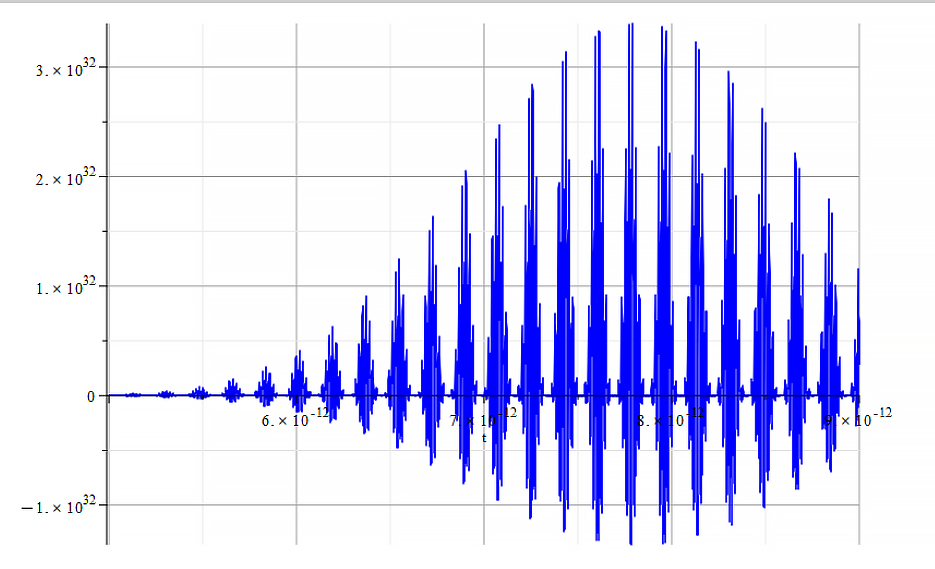 | 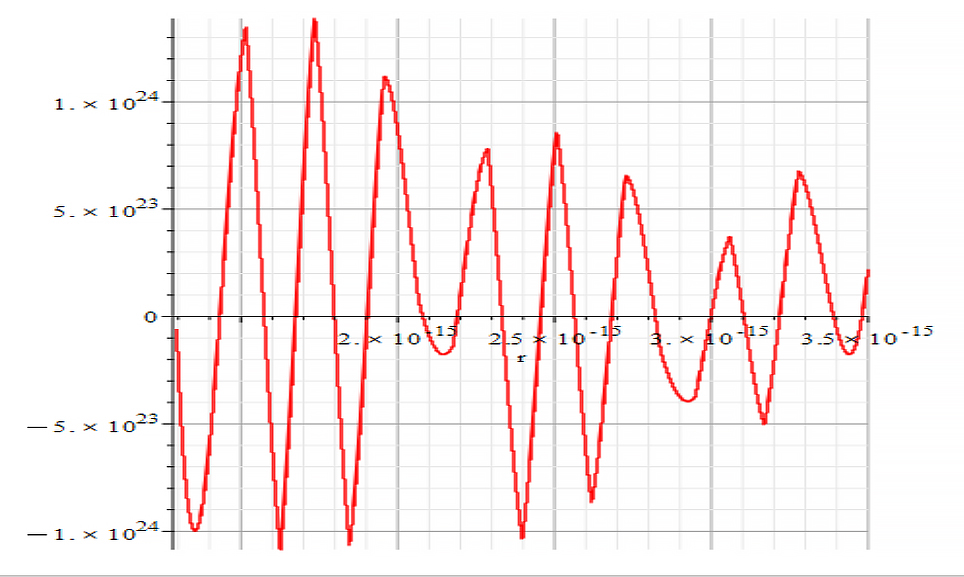 |
| Figure 39 Amplitude vs. time | Figure 40 Amplitude vs. displacement |
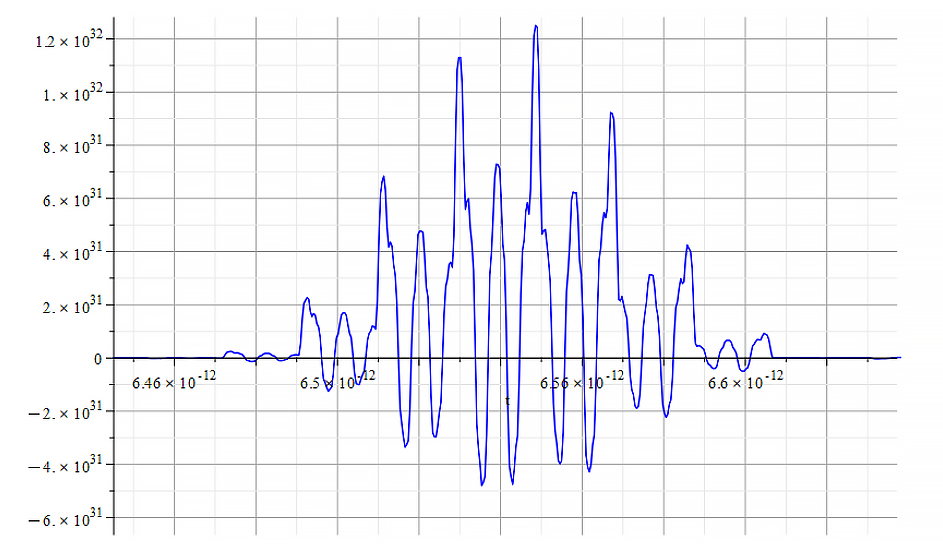
Amplitude vs. time. Expanding one packet (beat)
Fig. 39-41: No external wave is acting on the nucleus (natural nuclear emission), i.e., ![]() .
.
Additional parameters: ![]() and
and ![]() .
.
Low frequency beat: ![]() ; high frequency beat:
; high frequency beat: ![]() ; “carrier” frequency:
; “carrier” frequency: ![]()
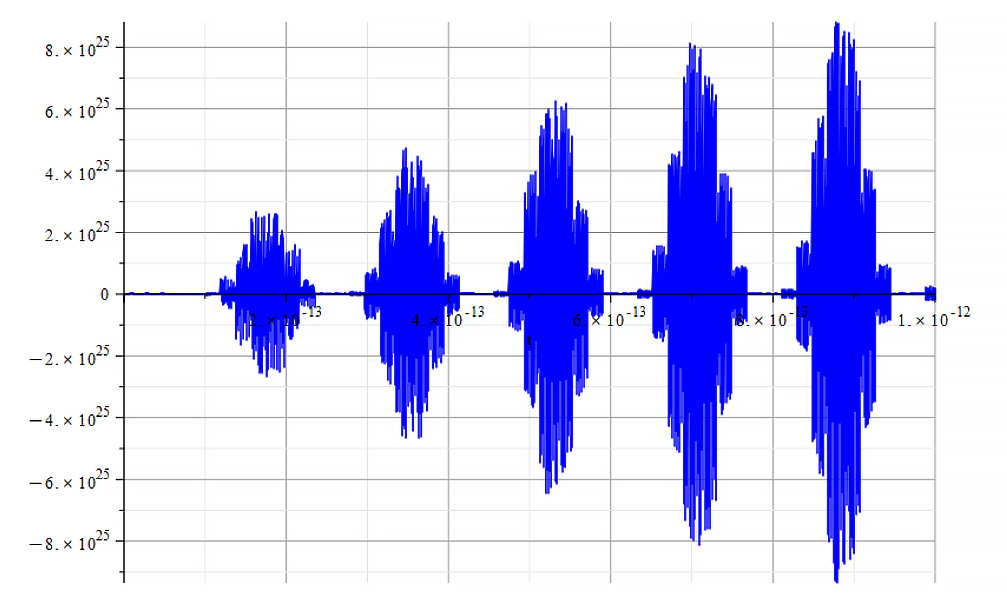 | 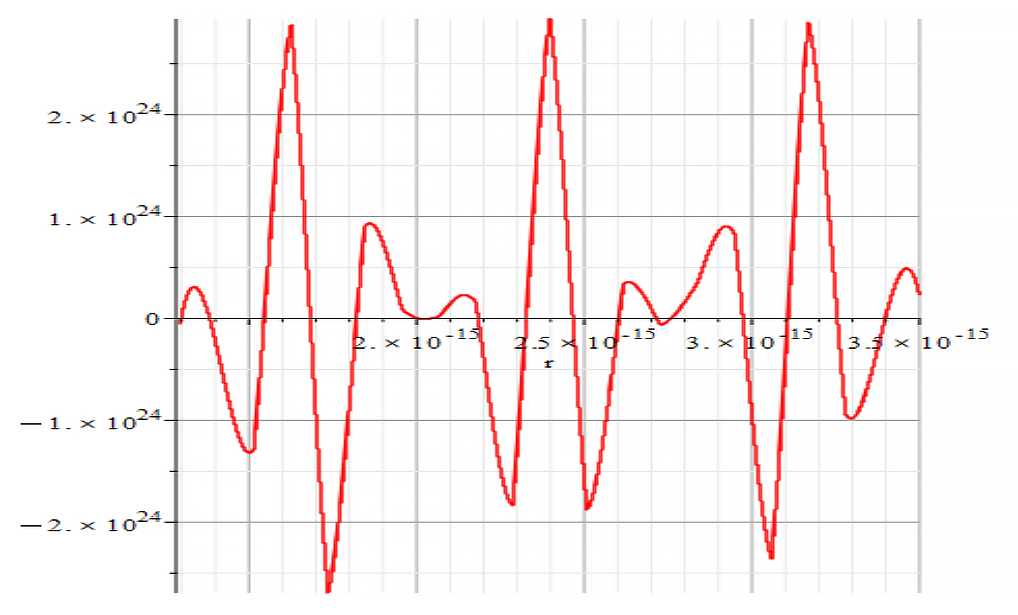 |
| Figure 42 Amplitude vs. time | Figure 43 Amplitude vs. displacement |
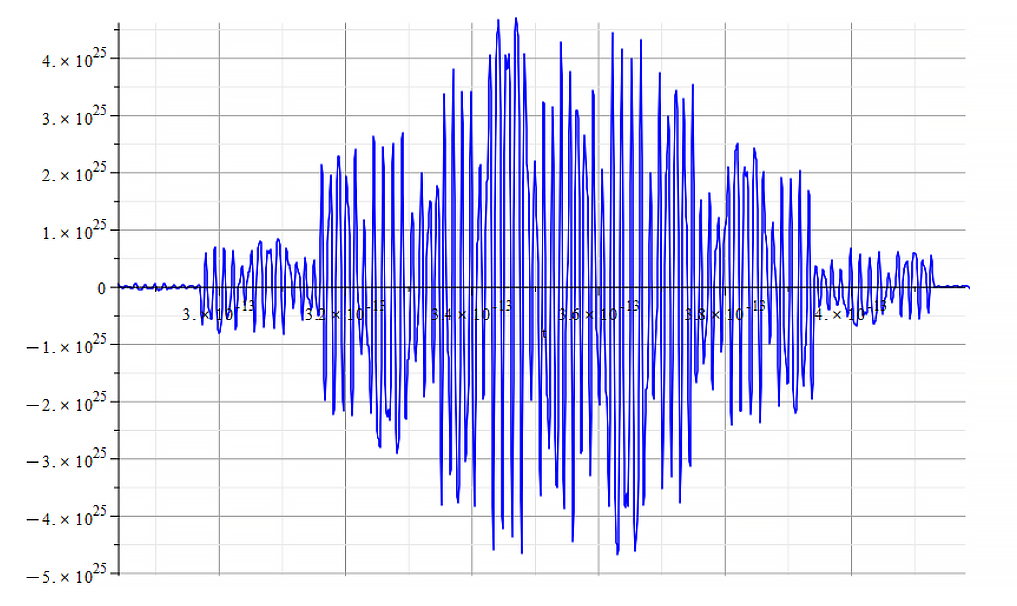
Amplitude vs, time. Expanding one big packet (double beat)
Fig. 42-44: external wave is acting on the nucleus ![]() ;
; ![]()
Additional parameters: ![]() and
and ![]() .
.
Low frequency beat: ![]() ; high frequency beat:
; high frequency beat: ![]() ; “carrier” frequency:
; “carrier” frequency: ![]() . No changes were observed with respect to the previous case.
. No changes were observed with respect to the previous case.
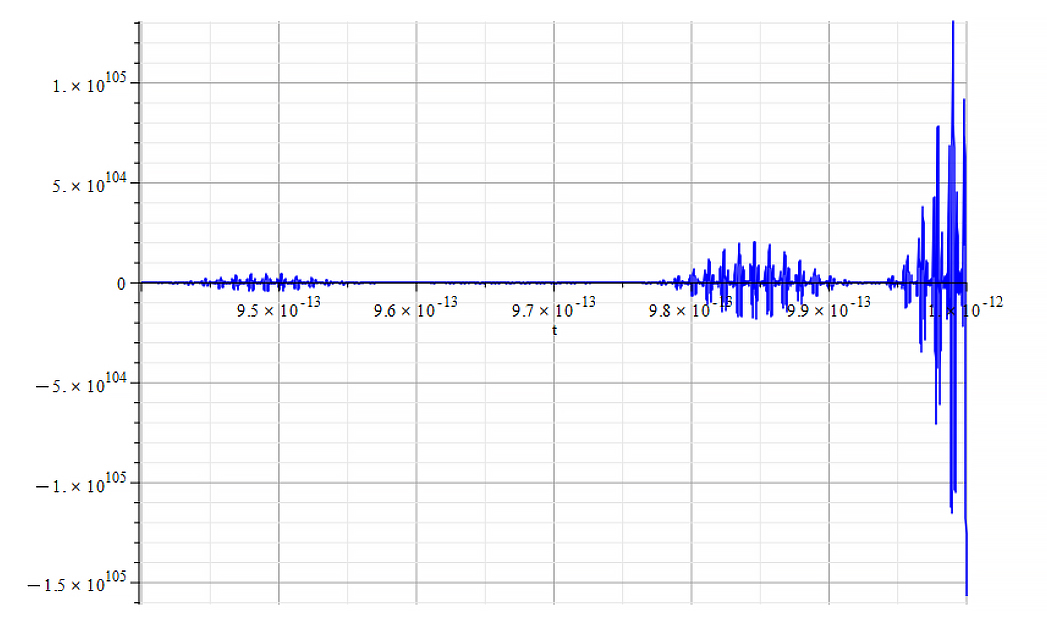 | 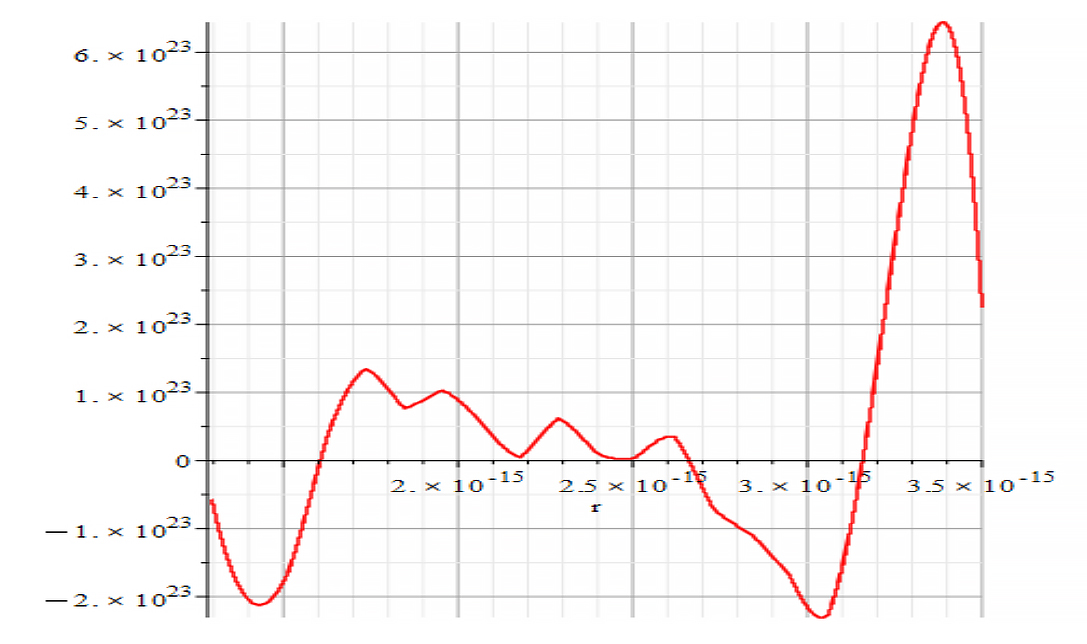 |
| Figure 45 Amplitude vs. time | Figure 46 Amplitude vs. displacement |
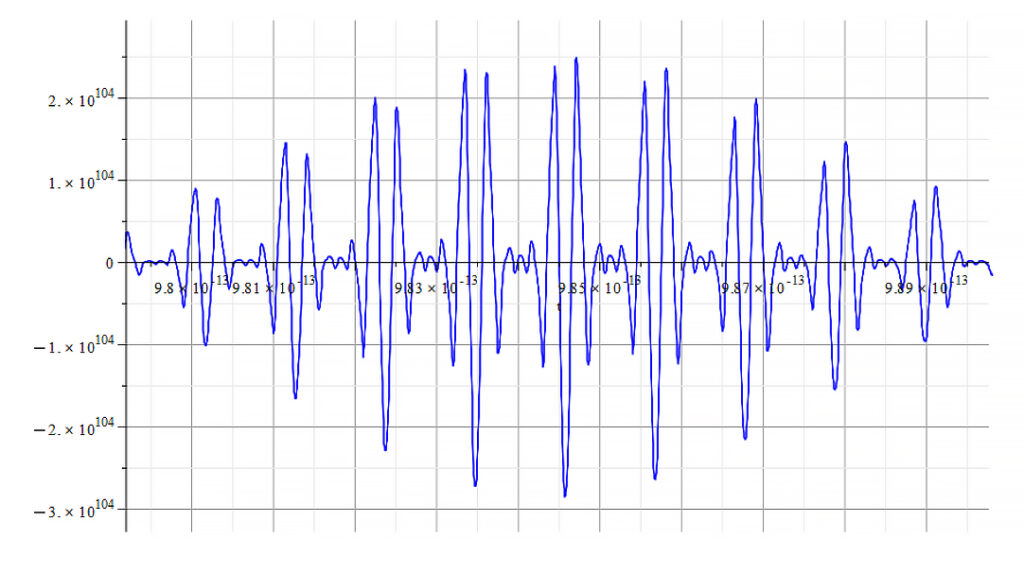
Amplitude vs, time. Expanding one big packet (double beat)
Fig. 45-47: external wave is acting on the nucleus ![]() ;
; ![]()
Additional parameters: ![]() and
and ![]() .
.
Low frequency beat: ![]() ; high frequency beat:
; high frequency beat: ![]() ; “carrier” frequency:
; “carrier” frequency: ![]() .
.
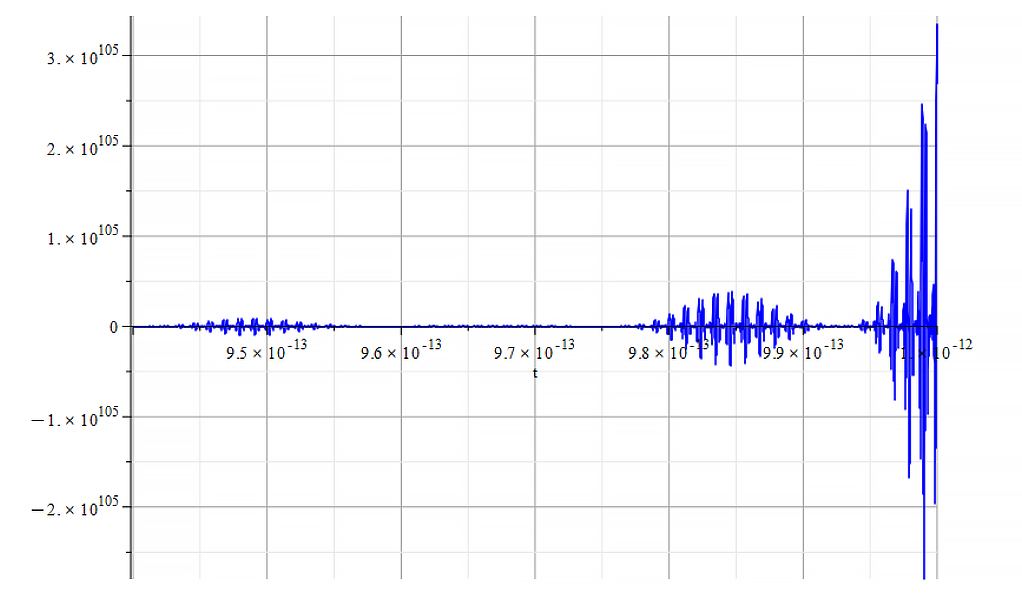 | 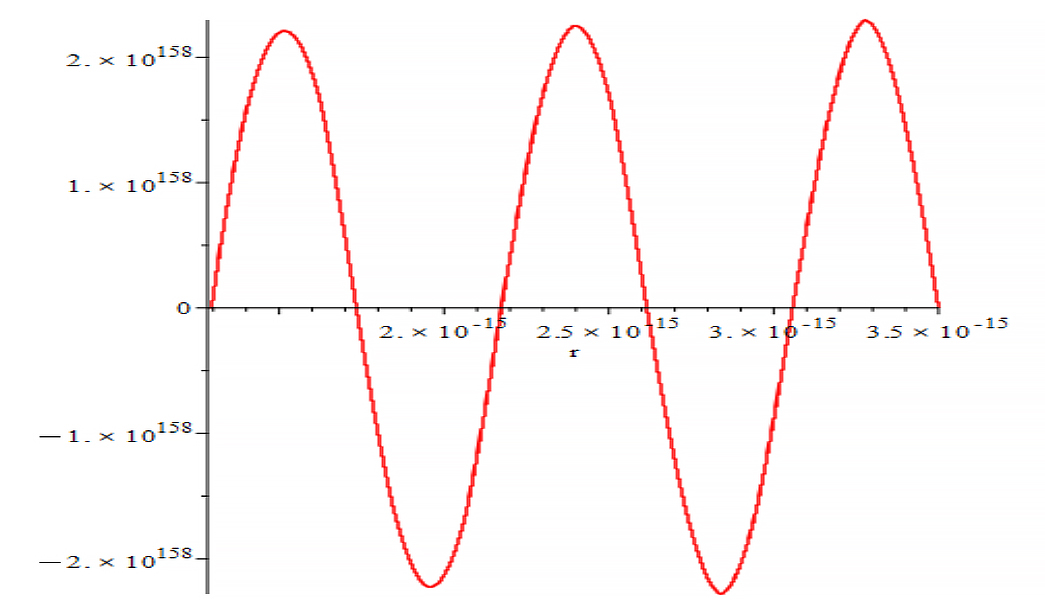 |
| Figure 48 Amplitude vs. time | Figure 49 Amplitude vs. displacement |
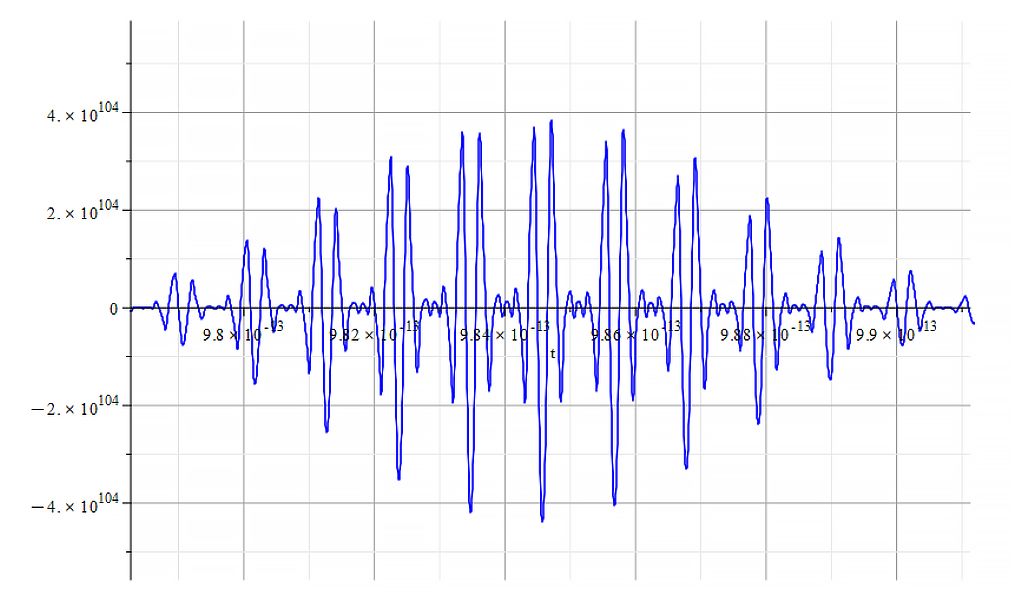
Amplitude vs, time. Expanding one big packet (double beat)
Fig. 48-50: external wave is acting on the nucleus ![]() ;
; ![]()
Additional parameters: ![]() and
and ![]() .
.
Low frequency beat: ![]() ; high frequency beat:
; high frequency beat: ![]() ; “carrier” frequency:
; “carrier” frequency: ![]() .
.
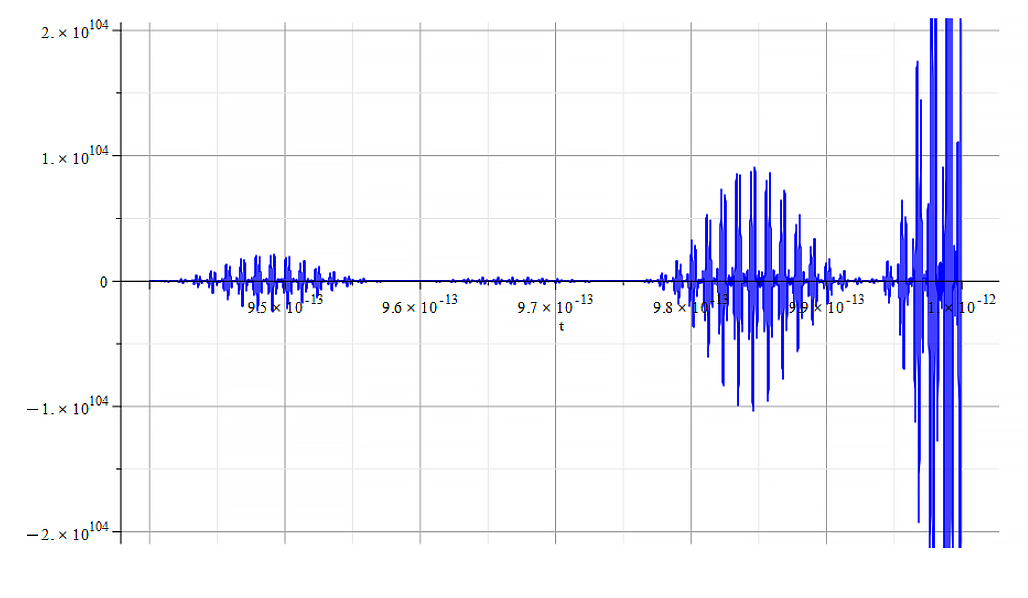 | 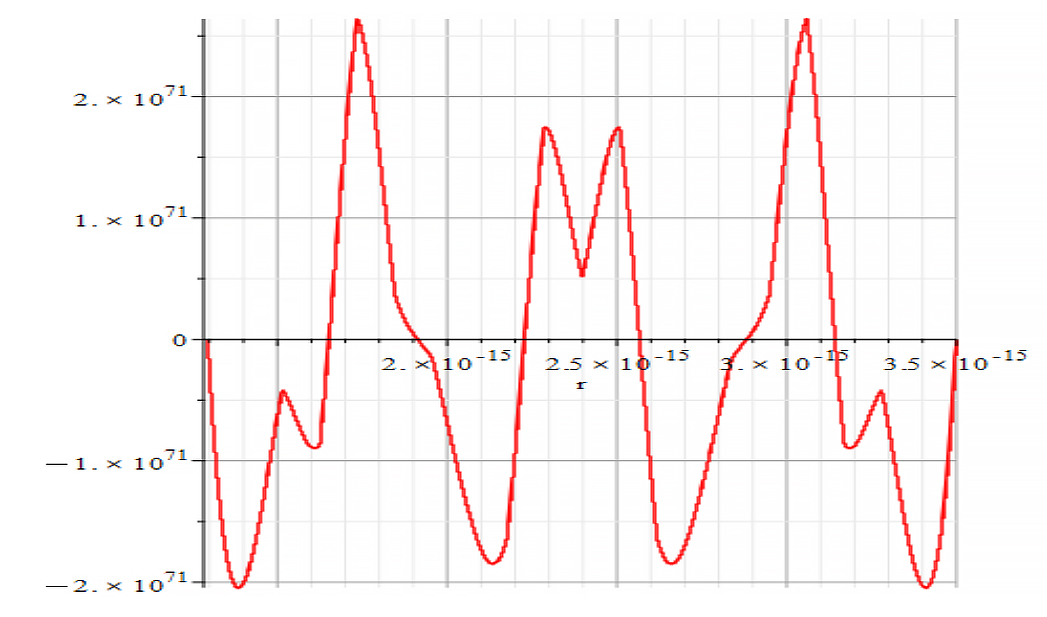 |
| Figure 51 Amplitude vs. time | Figure 52 Amplitude vs. displacement |
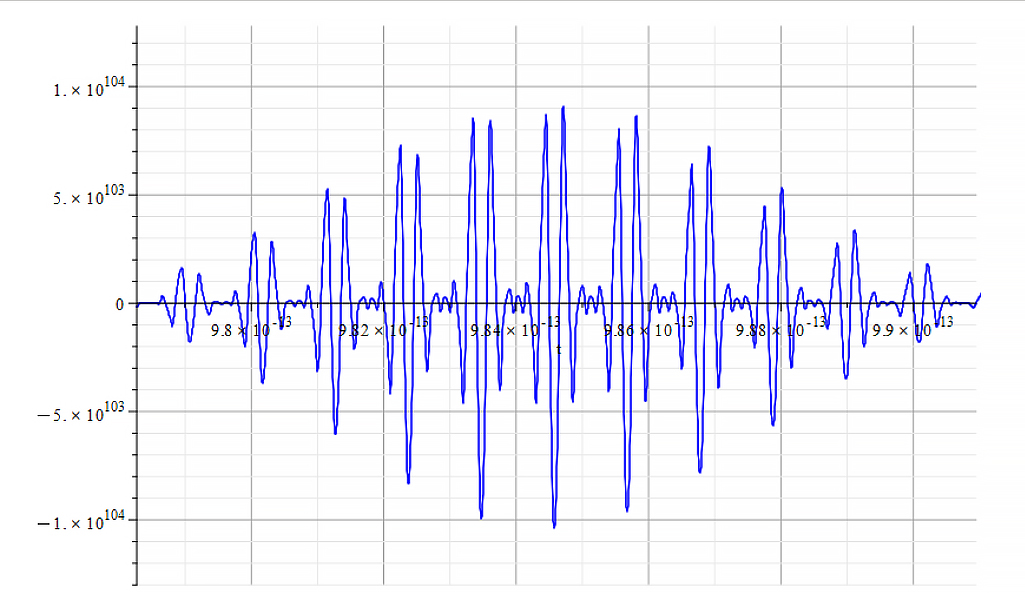
Amplitude vs, time. Expanding one big packet (double beat)
Fig. 51-53: external wave is acting on the nucleus ![]() ;
; ![]()
Additional parameters: ![]() and
and ![]() .
.
Low frequency beat: ![]() ; high frequency beat:
; high frequency beat: ![]() ; “carrier” frequency:
; “carrier” frequency: ![]() .
.
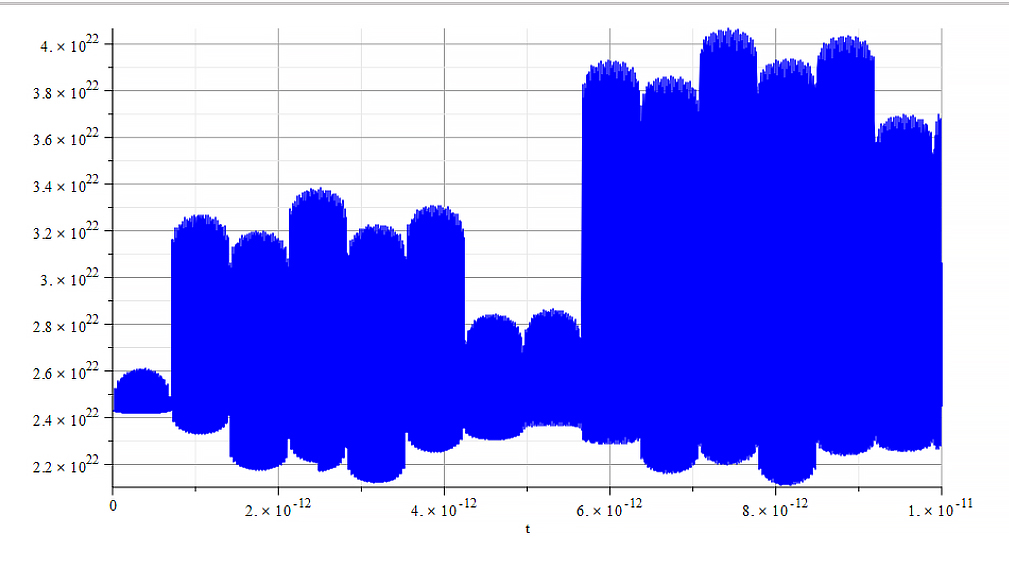 | 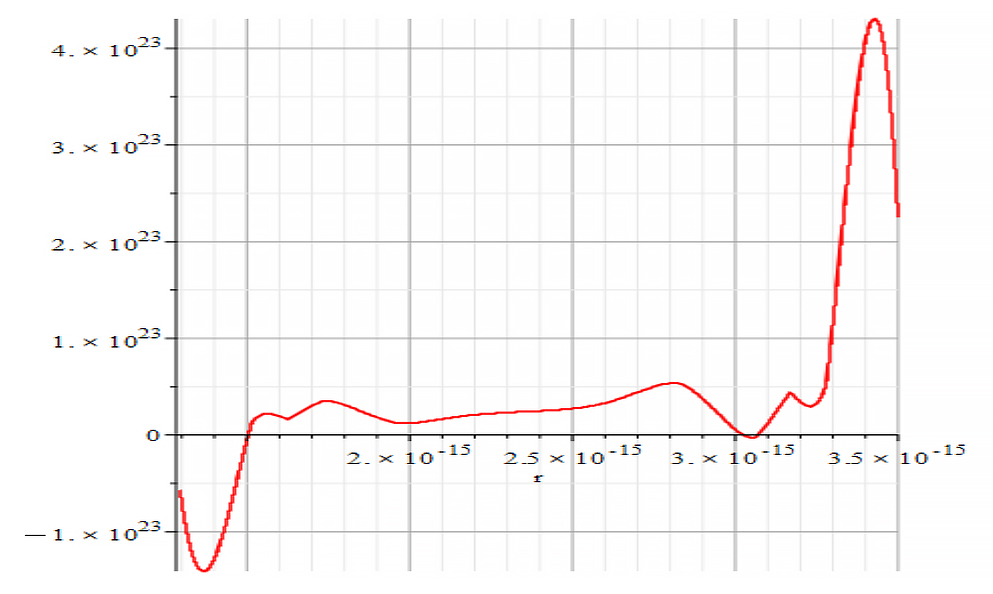 |
| Figure 54 Amplitude vs. time | Figure 55 Amplitude vs. displacement |
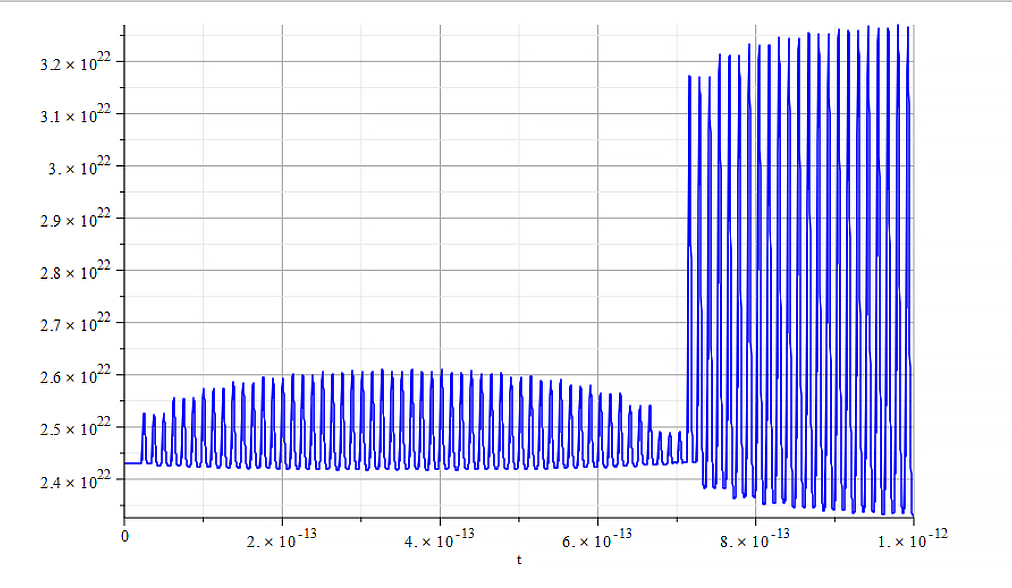
Amplitude vs. time. Partial expansion of beats
Fig. 54-56: external wave is acting on the nucleus ![]() ;
; ![]()
Additional parameters: ![]() and
and ![]() .
.
Beat frequency: ![]() ; “carrier” frequency:
; “carrier” frequency: ![]() .
.
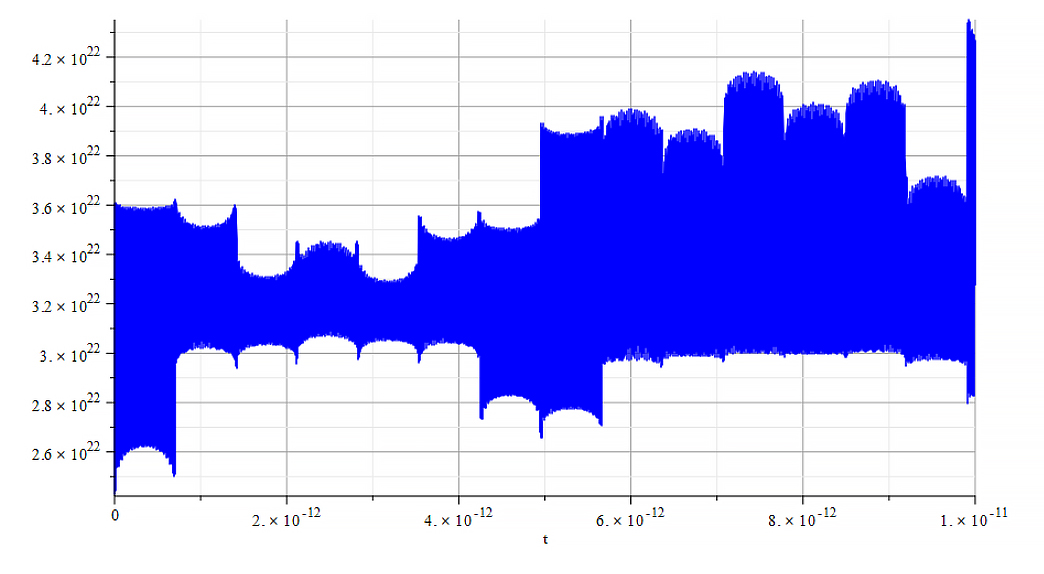 | 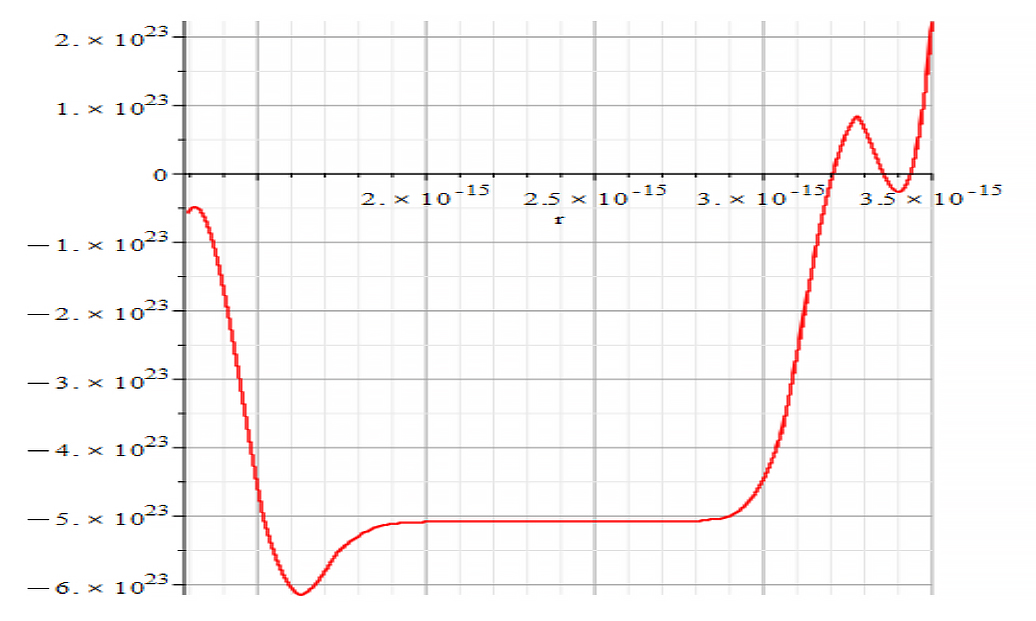 |
| Figure 57 Amplitude vs. time | Figure 58 Amplitude vs. displacement |
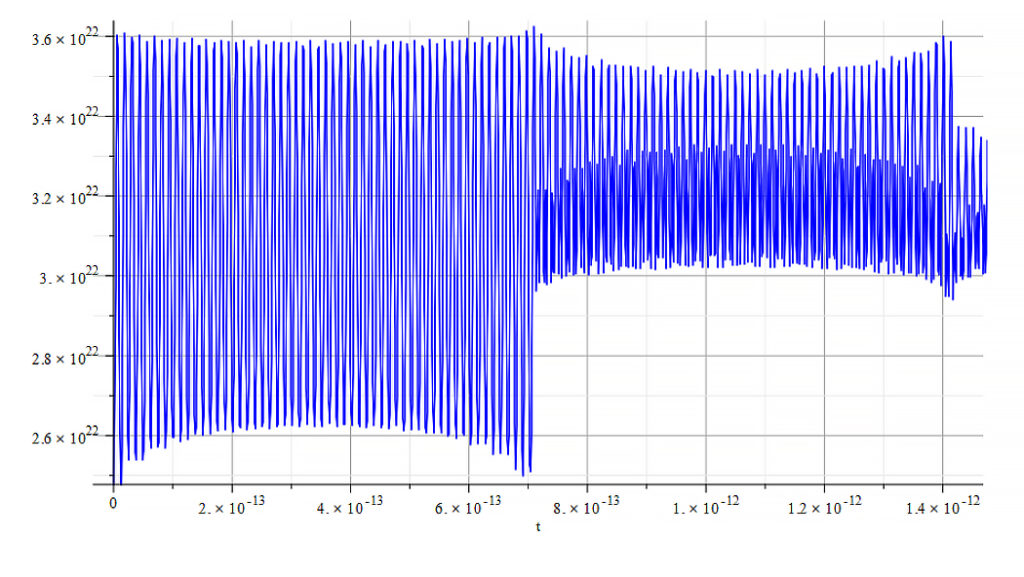
Amplitude vs. time. Partial expansion of beats
Fig. 57-59: external wave is acting on the nucleus ![]() ;
; ![]()
Additional parameters: ![]() and
and ![]() .
.
Beat frequency: ![]() ; “carrier” frequency:
; “carrier” frequency: ![]() .
.
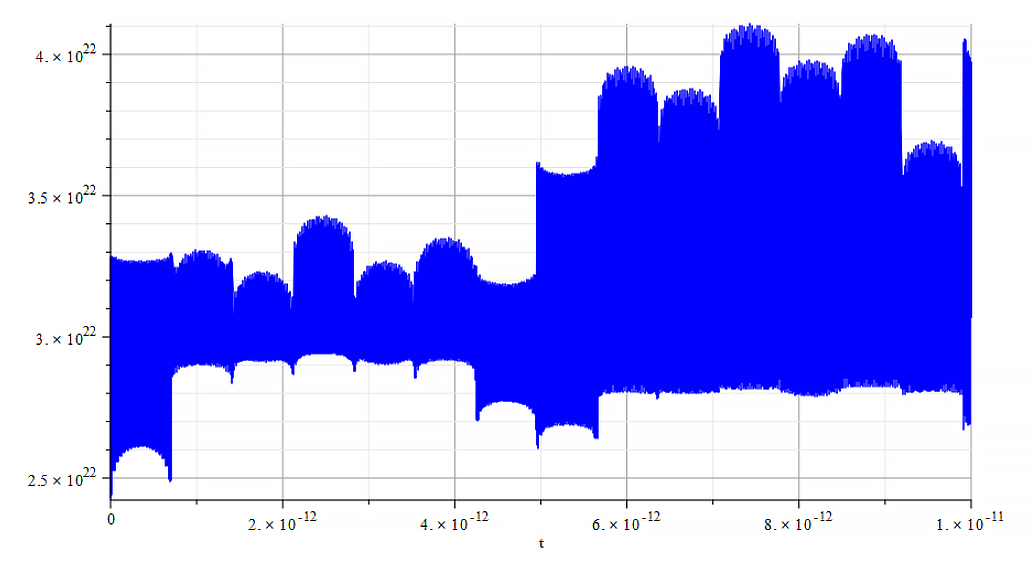 | 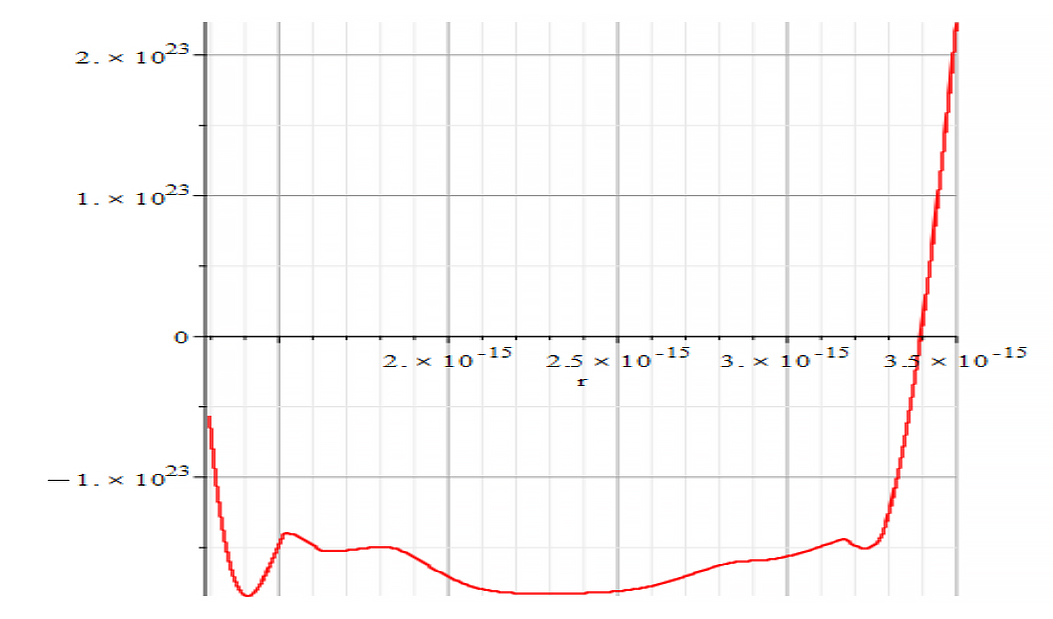 |
| Figure 60 Amplitude vs. time | Figure 61 Amplitude vs. displacement |
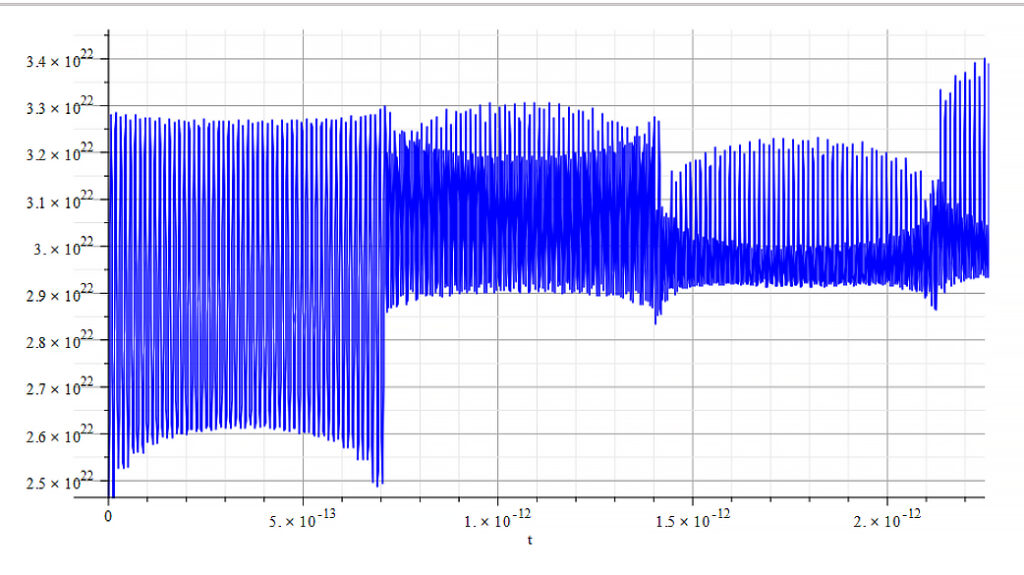
Amplitude vs, time. Partial expansion of beats
Fig. 60-62: external wave is acting on the nucleus ![]() ;
; ![]()
Additional parameters: ![]() and
and ![]() .
.
Beat frequency: ![]() ; “carrier” frequency:
; “carrier” frequency: ![]() .
.
As can be seen from the graphs, nuclear transmission conditions show little differences in beat and “carrier” frequencies with respect to the absorption state analyzed in previous paragraphs.
However, there are some differences in the amplitude of the interference wave, and the most important aspect is that its amplitude is never negative for high frequencies of the external wave.
Conclusions
Based on the New Atomic Model and the Universal Electrodynamic Force, two wave equations have been derived, the first accounting for the self-oscillation nature of the nuclear shells, while the second exposes the nuclear wave interference caused by the internal shell oscillations with an external wave.
It has been demonstrated that the first derived wave equation from shells’ self-oscillations, clearly predicts the emission of Aluminum according to international standards.
Moreover, the nuclear wave equation predicts emission lines for the Aluminum which are still unknown and need to be verified experimentally.
Both nuclear wave equations derived in this study may shed more light on the understanding of the nuclear nature, and open new possibilities to alter and control the mass.
Bibliography
[1]. Shanshan Yao, Xiaoming Zhou and Gengkai Hu, “Experimental study on negative effective mass in a 1D mass–spring system” (2008), New Journal of Physics (2008). https://iopscience.iop.org/article/10.1088/1367-2630/10/4/043020/pdf
[2]. J. P. Wesley, “Inertial Mass of a Charge in a Uniform Electrostatic Potential Field” (2001), Annales Foundation Louis de Broglie, Volume 26, nr. 4 (2001).
[3]. V. F. Mikhailov, “Influence of an electrostatic potential on the inertial electron mass” (2001), Annales Foundation Louis de Broglie, Volume 26, nr. 4 (2001).
[4]. M. Weikert and M. Tajmar, “Investigation of the Influence of a field-free electrostatic Potential on the Electron Mass with Barkhausen-Kurz Oscillation” (2019), ), Annales Foundation Louis de Broglie, Volume 44, (2019).
[5]. Timothy H. Boyer, “Electrostatic potential energy leading to a gravitational mass change for a system of two point charges” (1979), American Journal of Physics 47, 129 (1979), https://aapt.scitation.org/doi/10.1119/1.11881
[6]. A. K. T. Assis, “Changing the Inertial Mass of a Charged Particle” (1992), Journal of the Physical Society of Japan Vol. 62, No. 5, May, 1993, pp. 1418-142, https://journals.jps.jp/doi/abs/10.1143/JPSJ.62.1418?journalCode=jpsj
[7]. M. Tajmar, “Propellantless propulsion with negative matter generated by electric charges” (2013), Technische Universität Dresden (2013), https://tu-dresden.de/ing/maschinenwesen/ilr/rfs/ressourcen/dateien/forschung/folder-2007-08-21-5231434330/ag_raumfahrtantriebe/JPC—Propellantless-Propulsion-with-Negative-Matter-Generated-by-Electric-Charges.pdf?lang=en
[8]. M. Tajmar and A. K. T. Assis, “Particles with Negative Mass: Production, Properties and Applications for Nuclear Fusion and Self-Acceleration” (2015), https://www.ifi.unicamp.br/~assis/J-Advanced-Phys-V4-p77-82(2015).pdf
[9]. M. A. Khamehchi, Khalid Hossain, M. E. Mossman, Yongping Zhang, Th. Busch, Michael McNeil Forbes, and P. Engels, “Negative-Mass Hydrodynamics in a Spin-Orbit–Coupled Bose-Einstein Condensate” (2017), Phys. Rev. Lett. 118, 155301 (2017), https://journals.aps.org/prl/abstract/10.1103/PhysRevLett.118.155301
[10]. David L. Bergman, J. Paul Wesley, “Spinning Charged Ring Model of Electron Yielding Anomalous Magnetic Moment” (1990).
[11]. Joseph Lucas and Charles W. Lucas, Jr., “A Physical Model for Atoms and Nuclei”, Galilean Electrodynamics, Volume 7, Number 1 (1996), Foundations of Science (2002-2003), Part 1, Part 2, Part 3, Part 4.
[12]. Charles W. Lucas, Jr., “Derivation of the Universal Force Law”, Foundations of Science (2006-2007), Part 1, Part 2, Part 3, Part 4.
[13]. Arthur H. Compton, “The size and shape of the electron” (1918), Journal of the Washington Academy of Sciences, Vol. 8, No. 1, https://www.jstor.org/stable/24521544
[14]. David L. Bergman, “Modeling the Real Structure of an Electron” (2010), Foundations of Science.
[15]. David L. Bergman, “Shape & Size of Electron, Proton & Neutron” (2004), Foundations of Science.
[16]. Zoran Jaksic, N. Dalarsson, Milan Maksimovic, “Negative Refractive Index Metamaterials: Principles and Applications” (2006), https://www.researchgate.net/publication/200162674_Negative_Refractive_Index_Metamaterials_Principles_and_Applications
Related articles:
What is Charge? – The Redefinition of Atom – Energy to Matter Conversion
